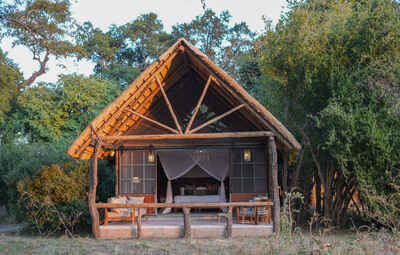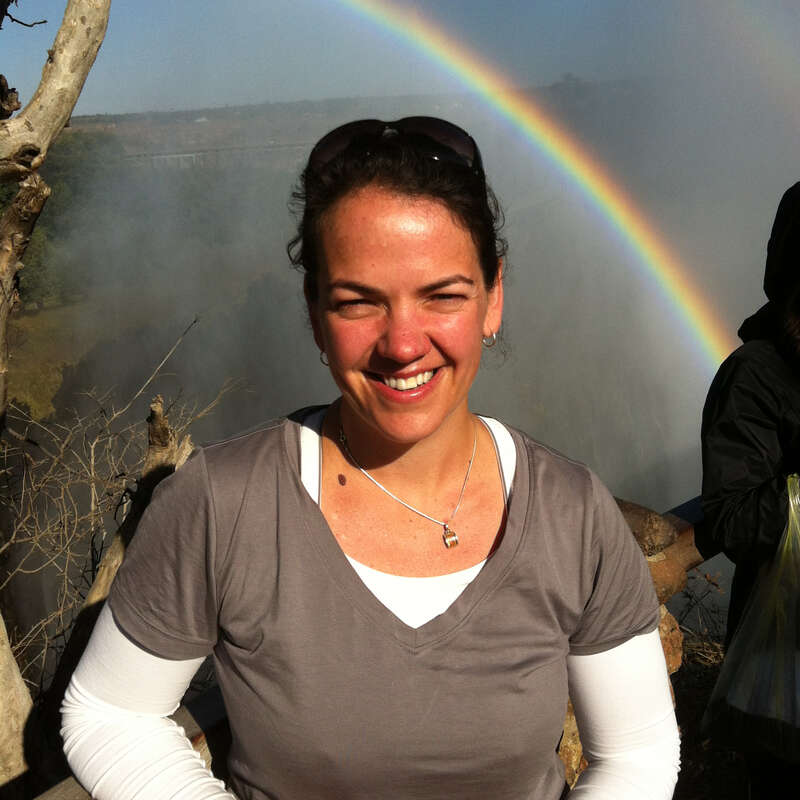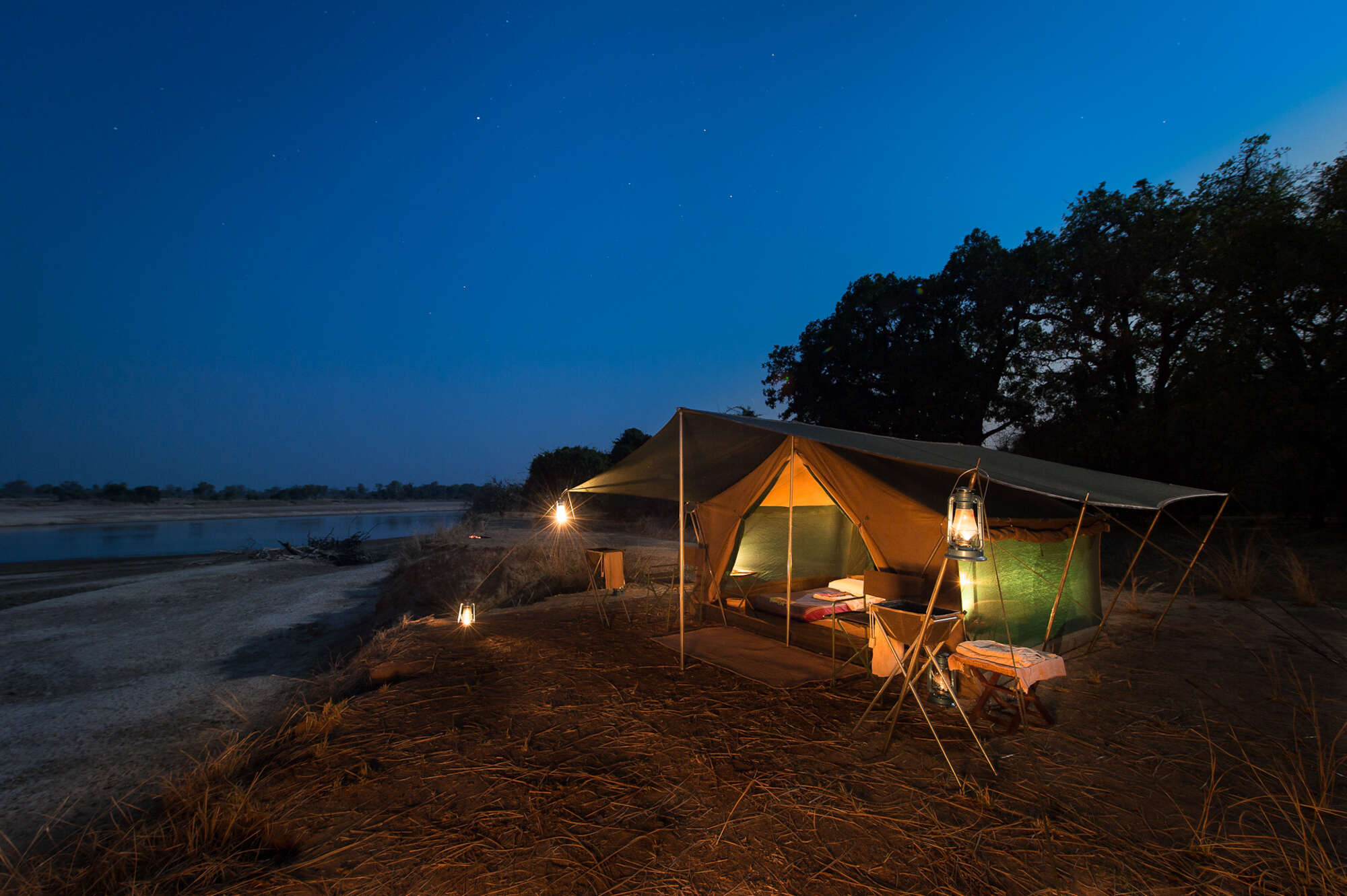About Mwamba Bushcamp
Mwamba is an utterly delightful camp, immersed in nature: it’s remote location and bushcamp vibe bring a touch of adventure to your safari.
Located at the confluence of the East Mwamba & main Mwamba rivers, the approach to the camp is lovely, following the snaking, dry sandy riverbeds through mopane forest, ebony groves & grasslands. To truly soak up the idyllic surroundings, you can choose to arrive on foot as part of a gentle walking safari from Mwamba’s sister camp, Kaingo.
The camp itself is shaded within a grove of particularly beautiful ebonies. A neatly swept, open-air circle is at the heart of camp life. There’s a banqueting table for social dinners, a fabulous bar lit by beaded chandeliers and festooned with python vines clinging to the magnificent ebony tree around with the camp is centered. The open-air lounge area, where comfortable sofas & carved Malawi chairs cluster beside a reference bookshelf, sits under a triangular shade cloth, and there are deep cushioned chairs around an adjacent metal firepit & a large birdbath to attract passing avian visitors. It’s a camp nestled in its natural surroundings.
The four bamboo reed-&-thatch chalets have thoughtful, rustic-chic interiors with delicate beaded linens and comfortable beds.
Thanks to its small size, Mwamba is very personal camp & activities are particularly flexible. Walking & driving safaris are on offer & the camp has its own hide, focused on a waterhole that regularly attracts birds & passing wildlife. The wildlife in the area is excellent: it’s one of South Luangwa’s best spots for Cookson’s wildebeest and eland are sometimes spotted in the area. You’re certainly guaranteed plenty of sightings to share over fireside drinks at the end of the day.
Our view
The camp’s name, Mwamba, means ‘heaven’ in the local Nyanja language, and we’d have to agree that a few nights spent here come pretty close!
We've visited Mwamba often since about 1995, and we love the true bushcamp feel that comes from Mwamba’s secluded location and the curated simplicity of the camp’s design. It’s managed to achieve the perfect balance between African adventure and modern comfort: lovely reed rooms furnished with comfortable beds and pretty linen, super, outdoor en-suite bathrooms and consistently fantastic food. We also love the flexibility of the activities here (especially the hides!) and the obvious passion of the guides.
Accommodation
4 thatched chalets
Children
Best for 12+
Open
01 Jun to 31 Oct
Activities

4WD Safari

Birdwatching

Cultural excursion

Fly-camping

Guided walking safari

Night drive

Sleeping under the stars
Traveller reviews of Mwamba Bushcamp
162 real, un-edited reviews from Expert Africa's travellers.
Arrived 24 May 2025, 3 nights
"Mwamba Bushcamp Our Second camp"
Overall rating: Excellent
Arrived 18 Sep 2024, 2 nights
"Mwamba Bushcamp review"
Overall rating: Excellent
Arrived 11 Oct 2024, 4 nights
"Mwamba Bushcamp review"
Overall rating: Excellent
Arrived 25 Sep 2024, 3 nights
"Mwamba Bushcamp review"
Overall rating: Excellent
Arrived 14 Sep 2024, 3 nights
"Mwamba Bushcamp review"
Overall rating: Excellent
Arrived 28 Aug 2024, 4 nights
"Mwamba Bushcamp review"
Overall rating: Excellent
Arrived 19 Aug 2024, 4 nights
"Mwamba Bushcamp review"
Overall rating: Excellent
Arrived 6 Jul 2024, 3 nights
"Mwamba Bushcamp review"
Overall rating: Excellent
Arrived 28 Jun 2024, 3 nights
"Mwamba Bushcamp review"
Overall rating: Excellent
Arrived 18 Jun 2024, 4 nights
"Mwamba Renewed"
Overall rating: Excellent
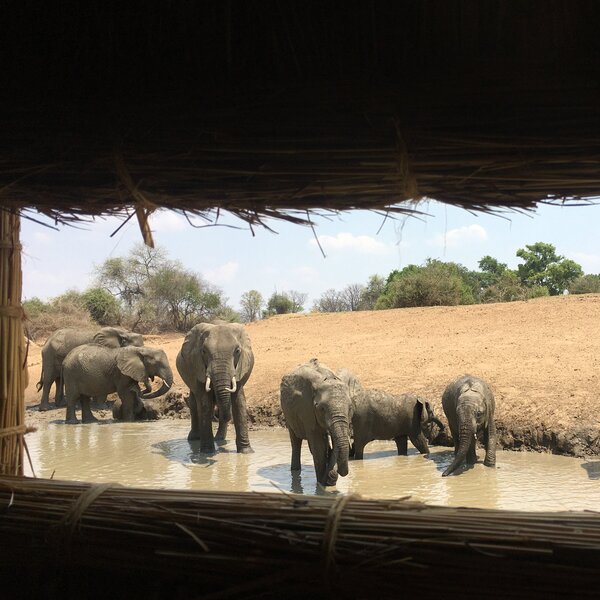
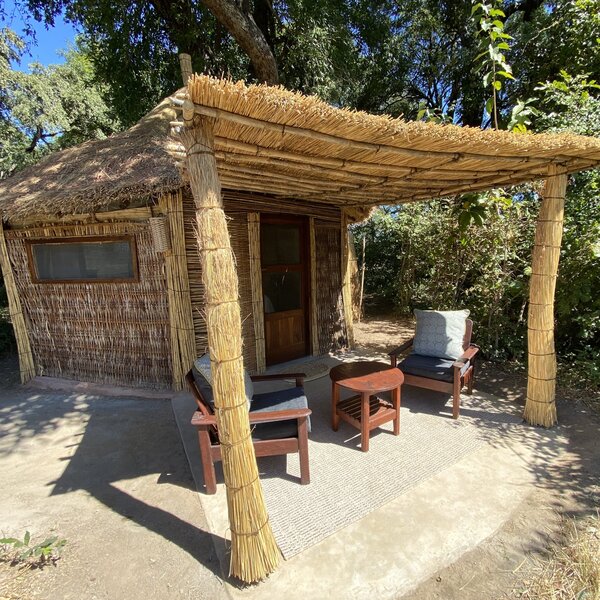
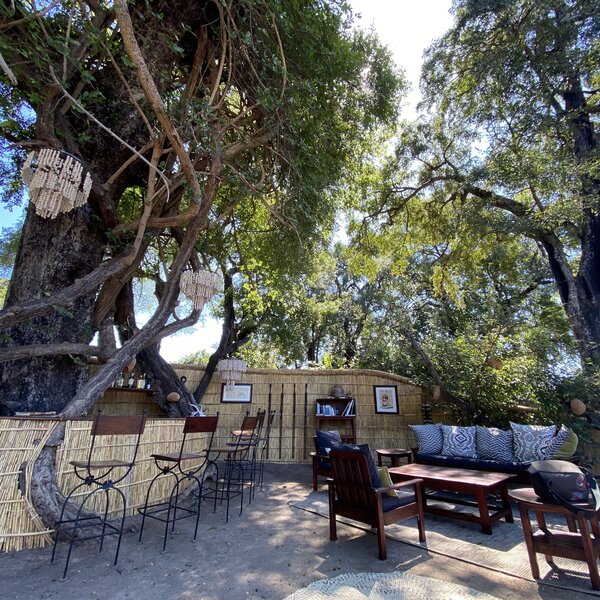
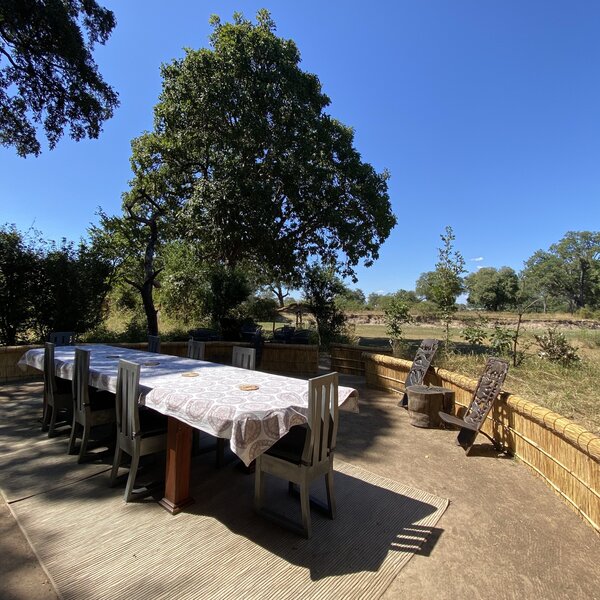
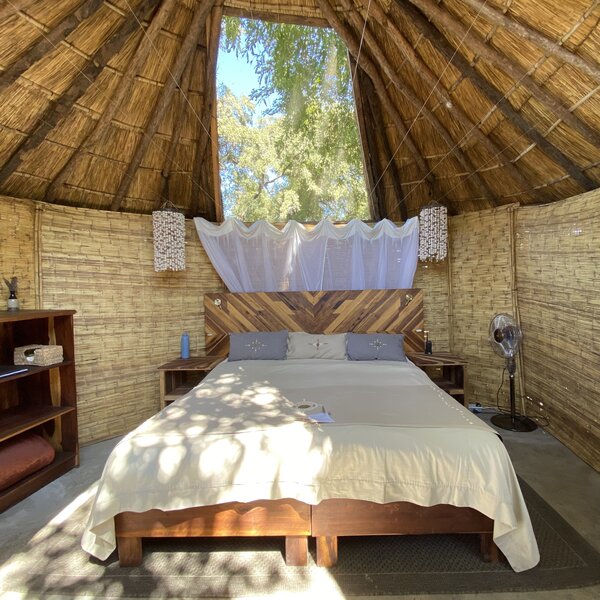

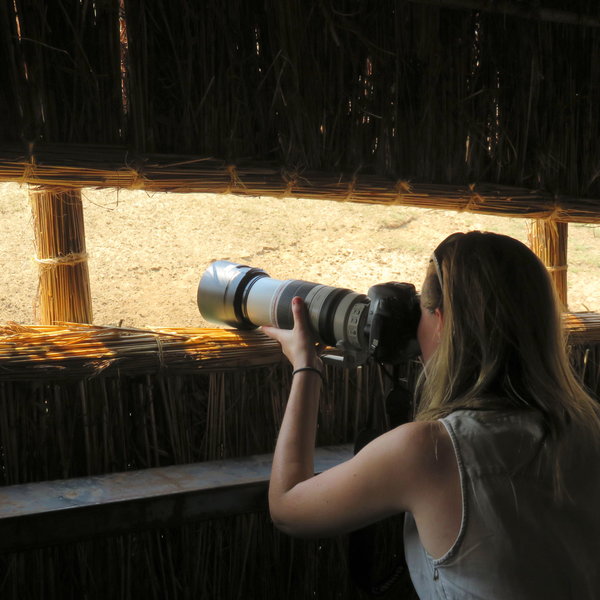
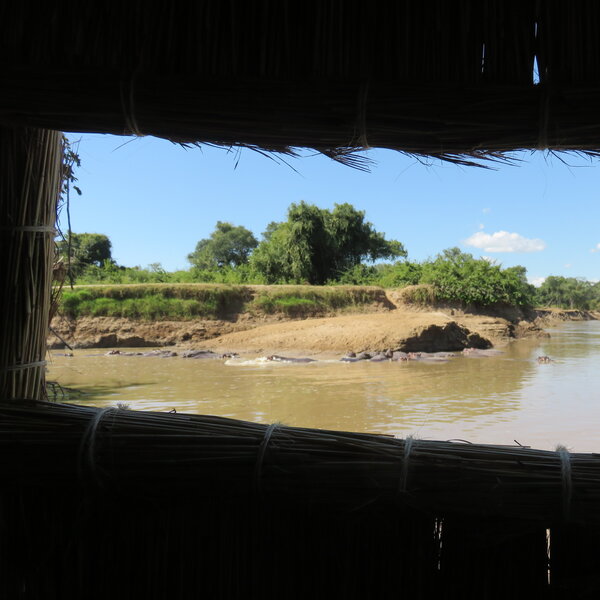
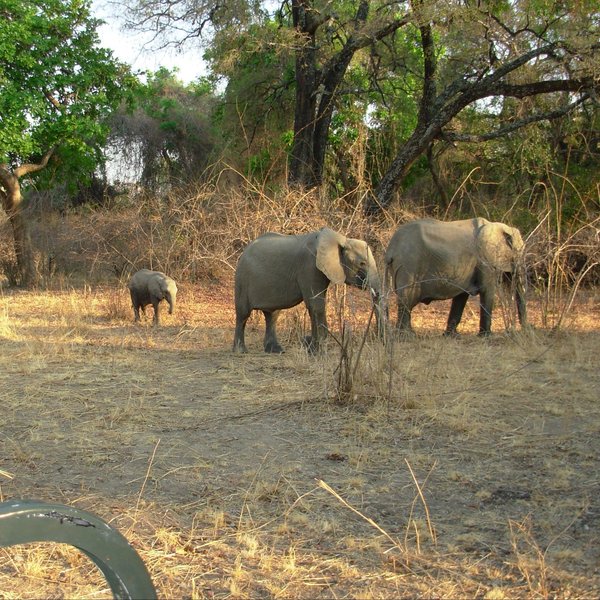
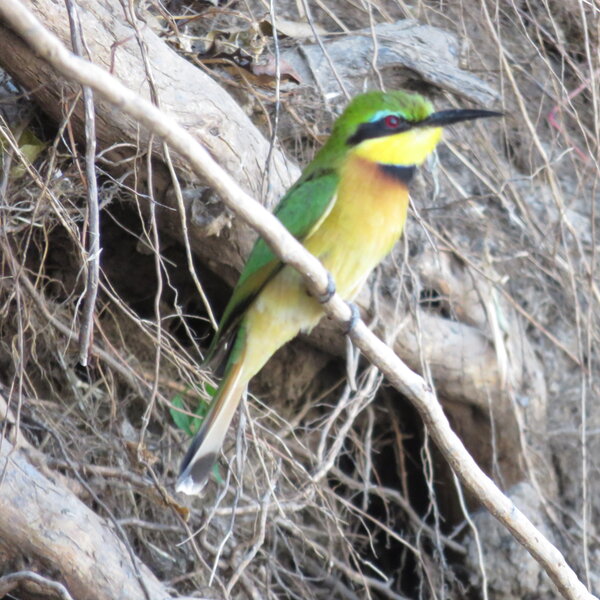
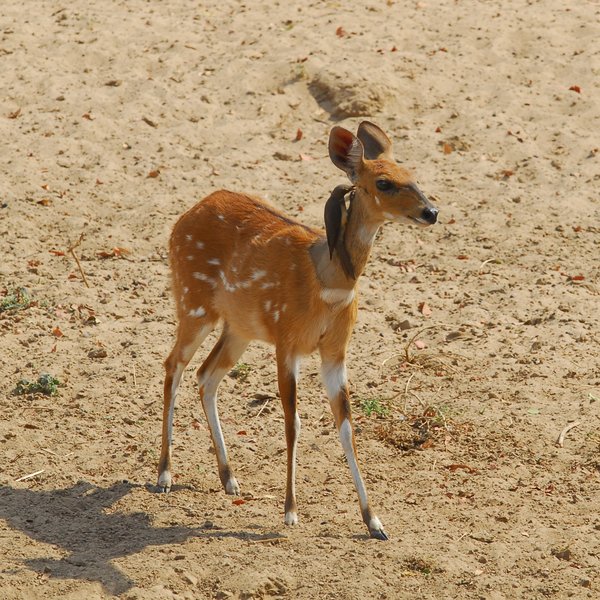
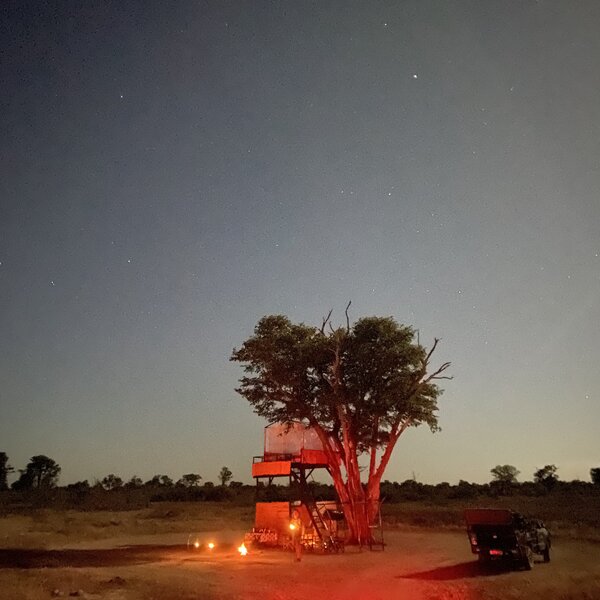
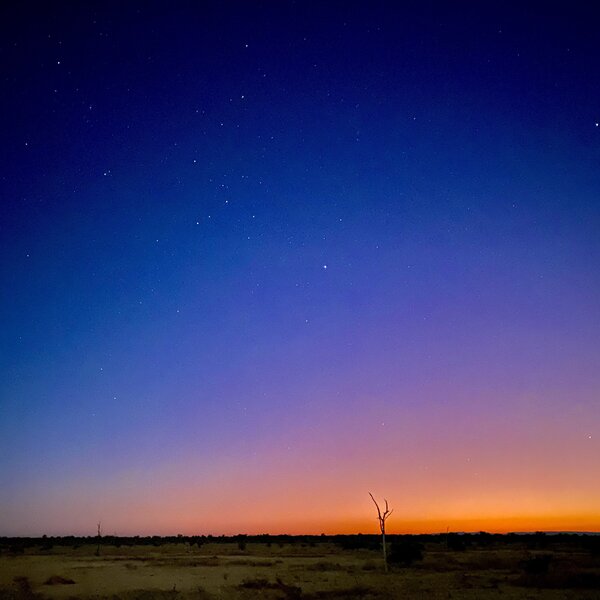
Expert Africa's gallery
When we travel we take lots of photos ourselves to give you a real and un-edited view of the safaris. See our 74 pictures and 3 videos of Mwamba Bushcamp to get the candid view.
View gallerySafaris visiting Mwamba Bushcamp
Just ideas, we'll always tailor-make a trip for you
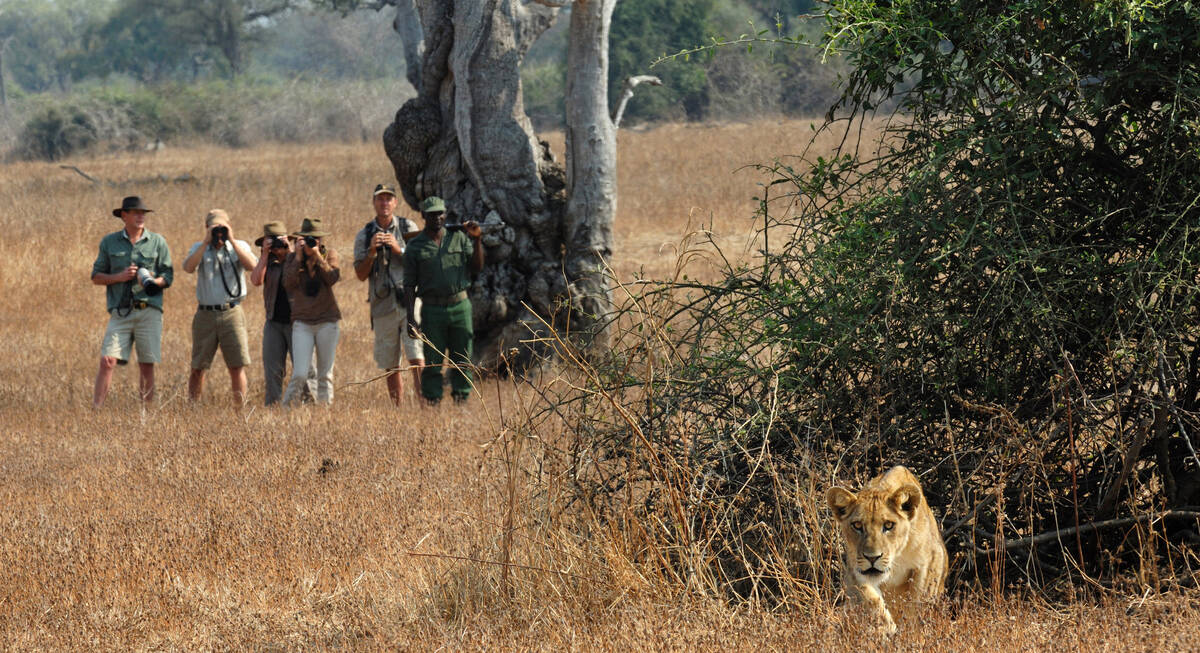
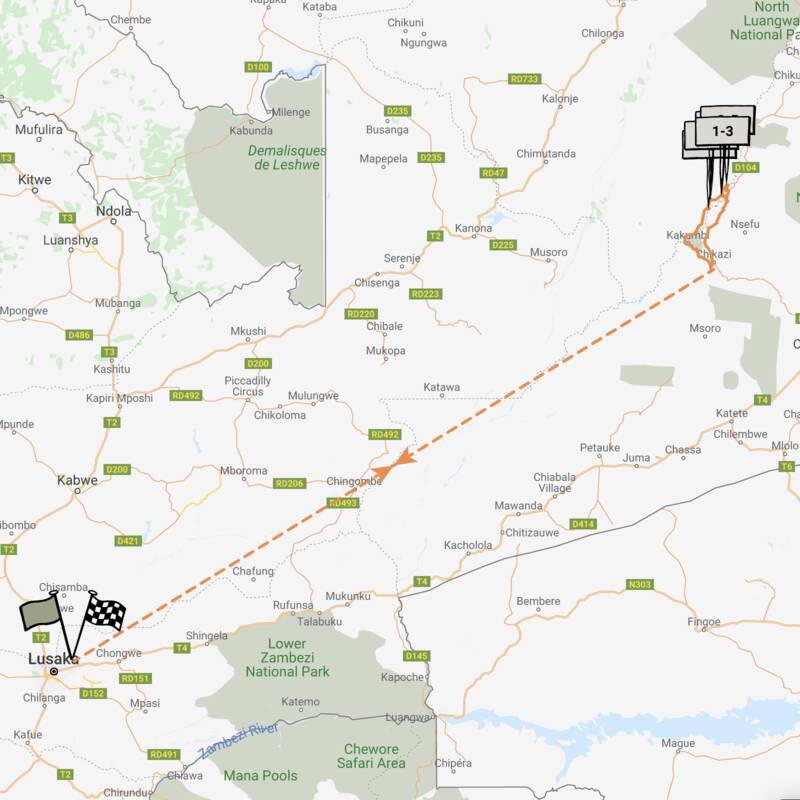
Perekani Walking Trail
10 days • 5 locations • 1 country
LUSAKA AIRPORT TO LUSAKA AIRPORT
Five smart but rustic bushcamps are the comfortable staging posts for this walking safari in South Luangwa. The route offers outstanding seclusion and rich wildlife with top-quality guiding throughout.
Visiting South Luangwa
US$9,590 - US$12,210 per person
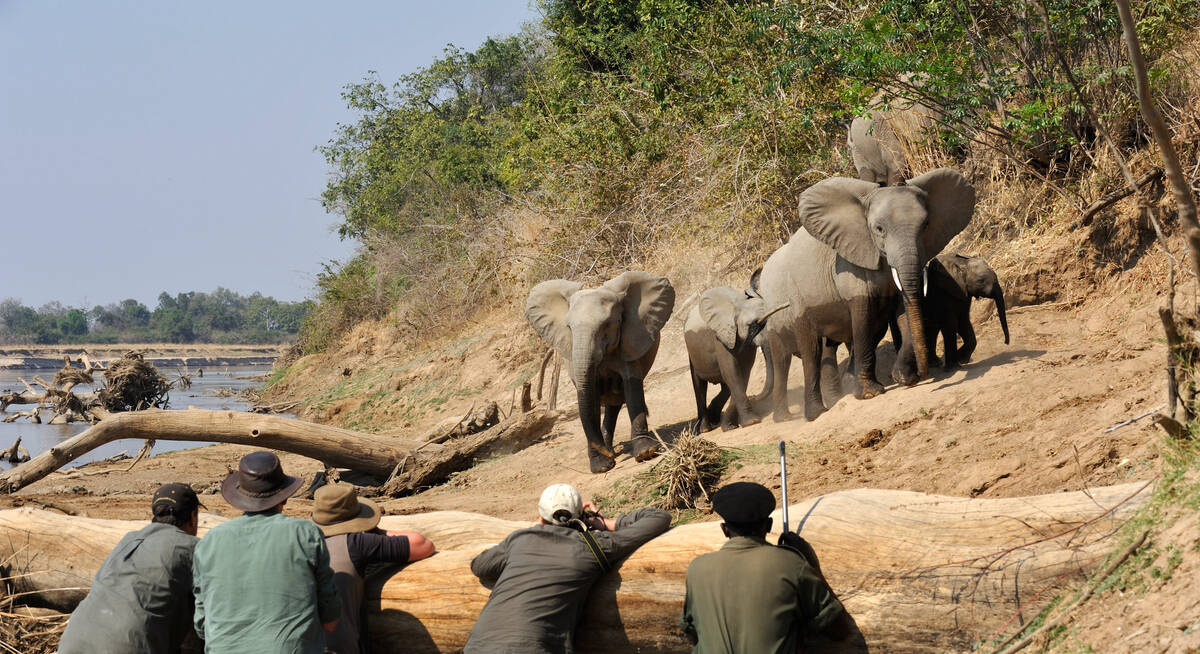
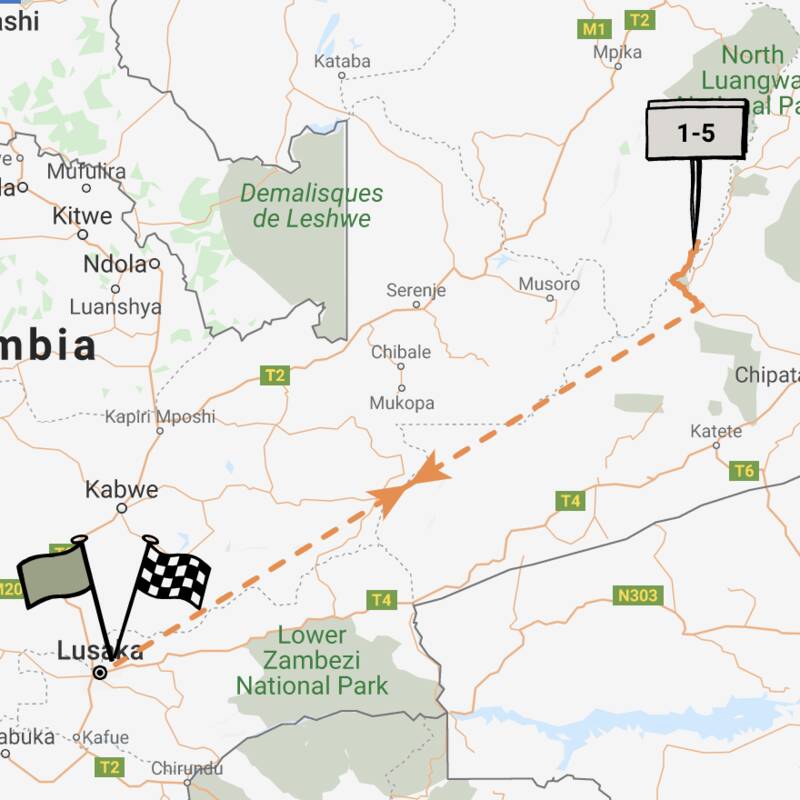
Boehm's Zebra Safari
7 days • 2 locations • 1 country
LUSAKA AIRPORT TO LUSAKA AIRPORT
This safari combines two high-quality owner-run camps in a very productive region of the South Luangwa. The guiding is excellent and with its hides this safari is perfect for serious photographers.
Visiting South Luangwa
US$7,490 - US$9,410 per person
Mwamba Bushcamp: Our full report
Small, intimate and very remote, Mwamba Bushcamp is set beneath the shade of magnificent ebony trees.
It's a calm, comfortable camp, steeped in nature, and overlooking a waterhole in the usually dry bed of the seasonal Mwamba River.
Owned by Derek and Jules Shenton - a seasoned conservationist and a keen photographer respectively – Mwamba is Kaingo Camp's lovely satellite bushcamp. The Shenton's dedication to wildlife, wilderness, sustainability and Zambian tradition is evident throughout their camps.
About 6km north of Kaingo, many guests choose to start their Mwamba adventure with a morning's walk from Kaingo, arriving in time for a delicious alfresco lunch.
Renovated beautifully in early 2024, the four thatched chalets at Mwamba Bushcamp have with reed walls and solid, polished floors, their natural tones offset by crisp white linen and delicately beaded cushions and throws and fabric mats on the floor. All of the chalets have twin or king-size beds and the chalet furthest from the main area, designated the honeymoon suite, has a larger veranda and a bit more privacy than the other chalets, though the small nature of this camp ensures space for everyone.
Each bed has a large walk-in mosquito net, tied back with pretty beads, that encompasses bedside tables and solar-powered lights and reading lamps. Outside each chalet is a shaded stone veranda with a table and chairs overlooking the riverbed.
A comfortable chair sits next to a standing fan, and the charging table has multinational and USB sockets. A small wooden lockbox is provided, along with mosquito repellent, whistle and radio.
Simple wooden furniture suffices, providing plenty of space for storing your belongings, with shelving, a stand for suitcases, a small wardrobe and a charging table. A large ebony tree recently fell into the main area, and you'll find the wood has been used to create many of the camp's newer pieces of furniture, including these tables!
Attached to each chalet is a large, open-air bathroom, which is enclosed by a tall reed wall and has a real bush feel. Built around enormous ebony trees for shade, they have stylish polished stone floors curving through from the bedroom to the toilet and shower. Although simple, they still have flushing toilets, natural stone basins and gas-heated showers for a more plentiful and consistent water supply.
The open chitenge (main area) at Mwamba is very simple and natural, with sandy floors and a low reed wall, and is lit at night by a combination of solar-powered lights, candles and paraffin lanterns. The central bar here is a real feature: built around a huge ebony tree entwined with python vines that support the drinks shelf. It's a great spot for a social drink before meals! There are also some cushioned chairs and a sofa, plenty of reference reading material and a great view of the surrounding bush, with huge sausage trees and their flowers an open invitation to nearby animals to wander past to feed, to keep you entertained. A new thatched lounge and dining area, down by the riverbed, was added in 2024.
Our meals at Mwamba were delicious - complemented by the fact that the majority of the fresh produce used in the camp's kitchen is grown or produced in the Shentons' large garden plot, just outside Mfuwe. Dinner is usually served communally in the main area, at a large wooden dining table (which Derek made), whilst lunch and breakfast are generally taken under a large thatched gazebo overlooking the Mwamba River.
Like Kaingo, Mwamba Bushcamp has a couple of stunning photographic hides overlooking perennial waterholes; these are frequently remodelled to give guests the best views of the surrounding location. One of these, The Last Waterhole Hide, is situated within the camp itself, exclusively for Mwamba guests' use; on our last visit we spent several enjoyable hours here, watching a wide variety of birds and animals, from Cookson's wildebeest and lion to mongoose and queleas, coming down to drink. The hide does, at times, have a webcam set up to capture the action - it's not as good as the real thing, but it may help with withdrawal symptoms once you're back home!
On request, guests at Mwamba can also make use of the carmine bee-eater hide, which is shared with Kaingo and is best in September and October. For those really interested in hides it would be ideal to combine a stay at Mwamba with Kaingo, which has a hide dug into the riverbank parallel to a hippo filled section of river. Kaingo also has a platform in a high riverside tree next to a regularly used crossing point, allowing for some fantastic photo opportunities.
These hides have been used by the BBC, National Geographic, Discovery Channel and many independent film-makers and photographers, including François d'Elbée.
Activities from Mwamba include walking safaris, game drives (day and night) and visits to the hides, all led by excellent guides. Unusually for most safari camps, Mwamba – like Kaingo – can operate three activities per day, with the one of these in the middle of the day being a visit to one of the hides, or perhaps time spent sitting by a nearby lagoon, for photography.
On a typical day you'll be woken to the sound of drums (usually 5.00–5.30am), followed by a quick breakfast around the campfire, before setting off on an early morning game drive or walking safari. You will usually return to camp around 10.00am, then brunch will be served, after which there's an opportunity to siesta or, as the majority of guests prefer, to head out to one of the hides. The hide close to camp is particularly good in the late morning, usually allowing close-up views of impala, buffalo, elephant and bushbuck as they come down to drink, as well as a myriad of different bird species. The waterhole can sometimes be much quieter – because the local "Mwamba" pride of lions likes to head down to nap next to the water!
Afternoon tea is served down by the dry riverbed before your afternoon activity.
Some guests choose to venture further afield on a full-day excursion. A half-day drive from Mwamba Bushcamp is a stunning “baobab forest” where you will find hundreds of 200–300-year-old baobab trees. Here, there is also a good chance of seeing some of the more elusive antelope such as eland, roan and hartebeest.
If you'd like to end off your day in camp – rather than out on an afternoon or full-day activity – then Mwamba has a great spot for sundowners! Just behind the camp Derek and his team have created a comfortable thatched seating area on top of a termite mound, with wide views over the bush.
With advance notice, guests can even enjoy a magical night's sleep at Mwamba's Numbu Starbed – a small platform on stilts overlooking the Numbu Plains and best enjoyed at new moon to experience the clarity of the night sky. Accessed by steps winding up to a lower deck with a firepit, where you'll enjoy drinks as the sun sets, the upper deck (all enclosed so to detract any would-be visitors!) has a large double bed at the top, swathed in a walk-in mosquito net. There's a fully plumbed toilet and basin here, and a free-standing bath for ultimate relaxation while you enjoy the views. A two-way radio, whistle and torch are provided, you are self-sufficient for the night, and will be left to enjoy the spectacular skies. It's an incredible experience and we loved it, though the camp will keep a chalet room ready and waiting for anyone who feels overwhelmed. The star bed is usually at additional cost, but for stays of seven nights or more across Mwamba and Kaingo, a complimentary night on one of the star beds is included, and we would highly recommend it.
For the truly adventurous, guests at Mwamba can also embark on the exhilarating Mwamba Camp-out, which is one of the truest wilderness experiences in the South Luangwa. After heading deep into the bush to Kapanda Lagoon on an afternoon walk with a senior guide and armed scout, you'll camp out for the night under the stars, with your bedroll set under a mosquito net beside the fire.
Like Kaingo, the Mwamba area has a very good diversity of game and birdlife. With varied habitats including wide open plains, mopane woodlands, waterholes, lagoons, thick riverine bush and the Mwamba River itself, expect to see plenty of zebras, Cookson's wildebeest (it's probably the best place in South Luangwa for these endemic animals), puku, impala, elephant, giraffe, waterbuck and bushbuck. We even saw the more timid eland on our last visit, and the ebony grove between Mwamba and its sister camp, Kaingo, is an incredibly good spot for the resident leopards. On a night drive you'll also have a good chance of seeing leopards, porcupines, civets and the white-tailed mongoose.
Whilst only novice birdwatchers, we have during various short stays spotted many species of kingfisher (including pied and brown-hooded), as well as fish eagles, lilac-breasted rollers, white-browed coucals, giant eagle owls, lovebirds, weavers and even a greater painted snipe.
Activities
4WD Safari
Birdwatching
Cultural excursion
Fly-camping
Guided walking safari
Night drive
Sleeping under the stars
Families & children
- Attitude towards children
- Mwamba is happy to take children over the age of 12 who are sensible and well-behaved.
- Property’s age restrictions
- Mwamba has an age restriction of 12 years, though this can be flexible for group family bookings.
- Special activities & services
- None.
- Equipment
- There’s no room in the chalets for an extra bed for a child, so those staying with children would need to split into different chalets to ensure that each child is sharing with an adult.
- Generally recommended for children
- This is a remote bushcamp that is better suited to older children.
- Notes
- Parents and guardians need to be aware that Mwamba is not fenced and animals do walk through the camp. On previous visits here we have had elephants in camp and a lion walk past our chalet. Children must never be left unsupervised.
Food & drink
- Usual board basis
- Full Board & Activities
- Food quality
- The team at Mwamba know how to keep both your days and your stomachs full! On our last trip to Mwamba Bushcamp, the food was, as always, very good. We are always amazed by the quality of food that the chefs can produce in their bush kitchens. With advance notice, the camp can also cater for vegans and vegetarians, also to a wide range of dietary requirements.
Breakfast is served around the campfire before the early morning activity and generally consists of tea and coffee, plus a selection of cereals, fruit and yoghurt, as well as freshly baked muffins or rusks.
When you return to the camp around 11.00am there's a very relaxed buffet brunch - we chose from spinach and egg filo pies, herb crusted pork chops, grilled corn on the cob, a particularly delicious beetroot and tamarind salad, served with freshly baked bread and a selection of chutneys and sauces, with a choice of churros and chocolate sauce or fruit salad and yoghurt to finish.
Afternoon tea is served at around 4.00pm, before your evening game activity – with sweet and savoury choices on offer, as well as drinks. On our last visit we chose from red pepper and cream cheese croutons and a delicious passionfruit cake.
Dinner is a set, three-course plated meal, accompanied by your choice of red or white wine. On a previous visit, we enjoyed light and crispy tempura vegetables with a soy and chilli dipping sauce for starter, then Lake Kariba pan fried tilapia on charred corn, with salsa verde, followed by a delicious chocolate amarula mousse with shortbread. - Dining style
- Group Meals
- Dining locations
- Indoor and Outdoor Dining
- Further dining info, including room service
- No
- Drinks included
- All drinking water, soft drinks, house wine and local spirits are included at Mwamba.
Our travellers’ wildlife sightings from Mwamba Bushcamp
Since mid-2018, many of our travellers who stayed at Mwamba Bushcamp have kindly recorded their wildlife sightings and shared them with us. The results are below. Click an animal to see more, and here to see more on our methodology.

100% success

100% success

100% success

100% success

98% success

98% success

96% success

92% success

92% success

50% success

31% success

15% success

3% success

0% success

0% success
Getting there
- Location
- South Luangwa National Park, Zambia
- Ideal length of stay
- We recommend a minimum of three nights at Mwamba Bushcamp, or 5–8 nights for a combined stay at Mwamba with its sister camp Kaingo.
- Directions
- Fly to Mfuwe airport, then transfer by road to camp. The drive, partly through villages, partly through the national park, takes approximately two hours, depending on the wildlife you see along the way.
- Accessible by
- Fly-and-Transfer
Special interests
- Birdwatching safaris
- The waterhole hide at Mwamba Bushcamp, or the private veranda outside each chalet, are great spots for birdwatching in Zambia. Thousands of carmine bee-eaters can also be seen from the camp's hide, below the nearby riverbank, between Sep – Oct.
- See ideas for Birdwatching safaris in Zambia
- Photography safaris
- Mwamba has two hides allowing you to get close to the wildlife, great for photography holidays in Zambia. In addition, all Mwamba's vehicles have clamp stabilisers, beanbags and camera dust covers – and their guides are acutely aware of what photographers want.
- See ideas for Photography safaris in Zambia
- Walking safaris
- Mwamba lies in a game-rich area which, combined with expert guides, makes it a great spot for walking safaris in Zambia. Guests combining their stay at Mwamba with its sister camp, Kaingo, can walk from camp to camp.
- See ideas for Walking safaris in Zambia
- Wildlife safaris
- The game hides at Mwamba camp are one of its main attractions, and they allow you to see some fantastic wildlife. The game-rich area and high-quality guides make this a great camp for wildlife safaris in Zambia.
- See ideas for Wildlife safaris in Zambia
Sustainability
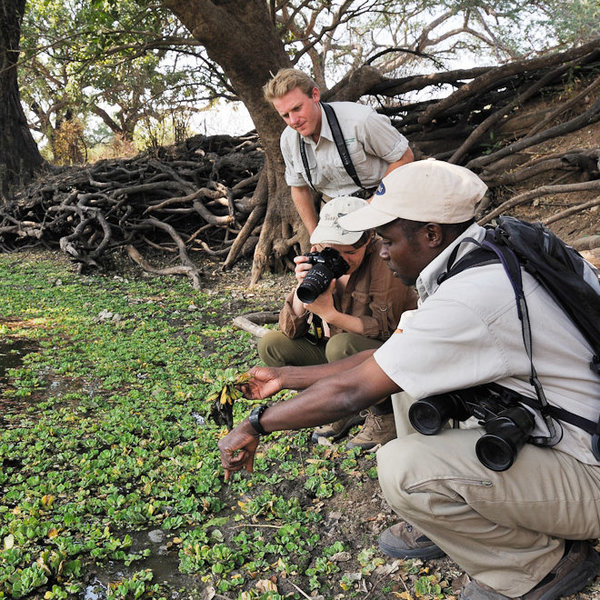
Authentic stay boosted by home-grown ingredients
Owned by Shenton family who has a proud history of three generations of wildlife conservation, Mwamba Bushcamp strives to create each experience #NourishedByNature, from the energy used in the camp solely powered by the sun ensuring nothing interferes with nature sounds, to the close-up wildlife hides, specially designed by the owner. Located deep in the South Luangwa National Park, far from the busy Mfuwe area to further limit its carbon footprint, Mwamba’s farm-to-fork initative comes to highlight the camp’s dedication to environmental protection.
The majority of the ingredients used in cooking guests’ meals are home-grown in an organic garden right outside the camp. The plot allows Mwamba to offer an array of quality fresh herbs, vegetables and fruit which would not be available otherwise. It also and acts as a playground for the hens supplying the camp with eggs used for brunches and in baking. Not only does the camp have an ongoing fresh herb supply throughout the season, but it also uses seasonal fruits and vegetables which make up the bulk of ingredients in guests and staff meals.
Additionally, to educate tourists on the importance of home-grown ingredients, Mwamba ensures that guests are aware of the origins of the ingredients. When presenting the menu, the Executive Chef reiterates which of the meals are created solely from the Shenton Plot. Guests also get the chance to stop at the plot on either their arrival or departure while the staff briefly stops to collect fresh products for the camp, and get to see the lush gardens.
At the moment, careful waste management is used to benefit the nutritious compost fertilizing the plot and bring a minimal environmental impact on the area.
See more great sustainability projects in Zambia
Communications
- Power supply notes
- A dedicated solar-powered battery panel ensures each chalet has enough power to run the lights, the standing fan and the 24-hour charging points for electronics.
- Communications
- This is a bush camp, without a direct phone line or cellphone reception (aside from the local Zamtel network – which doesn’t seem to work on international cellphones). However, there is WiFi in the camp’s main area, albeit with limited bandwidth.
Mwamba does have a radio and keeps in touch with Kaingo and other camps in the park. - TV & radio
- There are no radios or TVs here.
- Water supply
- Borehole
- Water supply notes
- The handbasins are plumbed in and each room has a flush toilet, and gas-heated showers.
Health & safety
- Malarial protection recommended
- Yes
- Medical care
- Members of management are first-aid trained. The closest doctor is in Mfuwe (90 minutes’ fast drive away). For medical emergencies, Mwamba has links to a flying-doctor service.
- Dangerous animals
- High Risk
- Security measures
- Guests are not allowed to walk around alone after dark, and will be escorted to their chalets after dark. There is a whistle in each room, in case of an emergency.
- Fire safety
- There are fire extinguishers located at every chalet and around the camp.
Useful info
- Disabled access
- On Request
- Laundry facilities
- A complimentary laundry service is included, except for ladies’ underwear, for which washing powder is provided in the bathrooms.
- Money
- No exchange facilities are offered.
- Accepted payment on location
- Everything, excepting gratuities, is included at Mwamba, but additional payments may be made in cash only; kwacha – the local currency – is preferred, but US dollars are also accepted. PayPal can also be used – with a 5% surcharge.
Plan and book your trip with Expert Africa
All of our trips are tailor-made, so we'll always adapt them to suit you. Talk to an Expert and let us plan and arrange your perfect trip.

Talk to an Expert
Call or email us now! We’ll match you with the Specialist in our team who is best suited to help you. Then together we can start planning your trip.

Set up your itinerary
Based on our experience and your ideas, your specialist will create a detailed, costed itinerary. We’ll refine it together, until we have a trip that you’re perfectly happy with.

Prepare for your trip
The same Specialist will make the seamless arrangements for your trip, send you detailed travel documents, and be available to answer any questions before you depart.

Travel with peace of mind
After you set off, you’ll be cared for by our partners in Africa, most of whom have worked with Expert Africa for decades. And if you ever need us urgently, we’re available 24/7.

When you return
We love to learn about your trip, and so will always be grateful if you’ve the time to give feedback to your Specialist when you return.
Mwamba Bushcamp's location
Look closer at the environment and surroundings of Mwamba Bushcamp.
Excursions from Mwamba Bushcamp
Optional extra day-trips and excursions possible whilst you're staying at Mwamba Bushcamp. Talk to us: these are usually best arranged before you go.
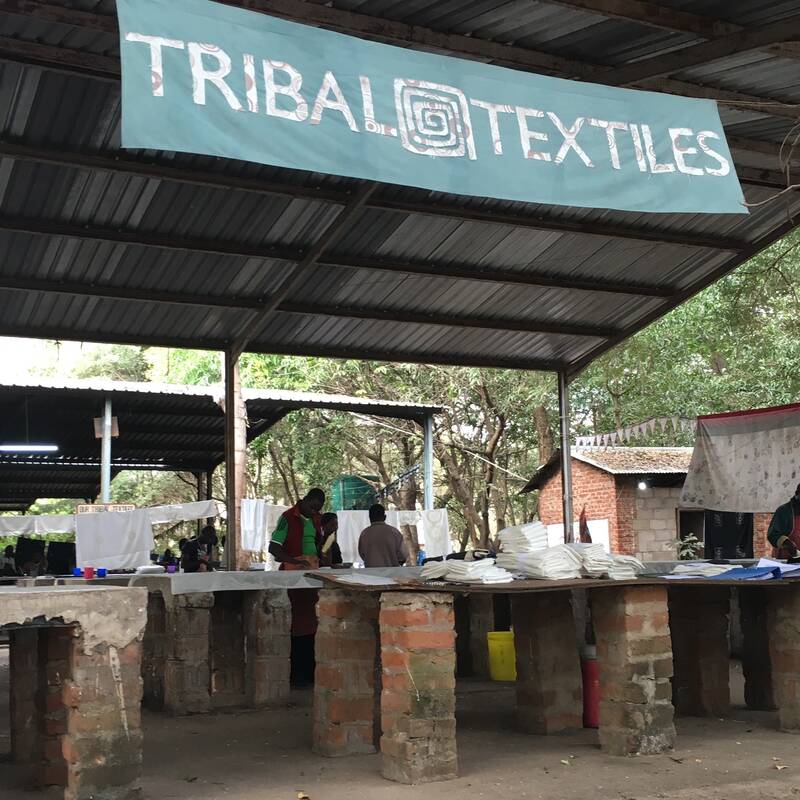
Tribal Textiles Tour
One - two hours
Visit the Tribal Textiles workshop, where hand-painted textiles are produced by more than a hundred local people. The workshop is close to Mfuwe Airport, so is ideally placed for a stop en route to/from the South Luangwa. With products ranging from cushion covers to bags and T-shirts, it's a great place for souvenir shopping while at the same time supporting the local community.
More about Tribal Textiles TourOther lodges in South Luangwa National Park
Alternative places to stay in this same area.
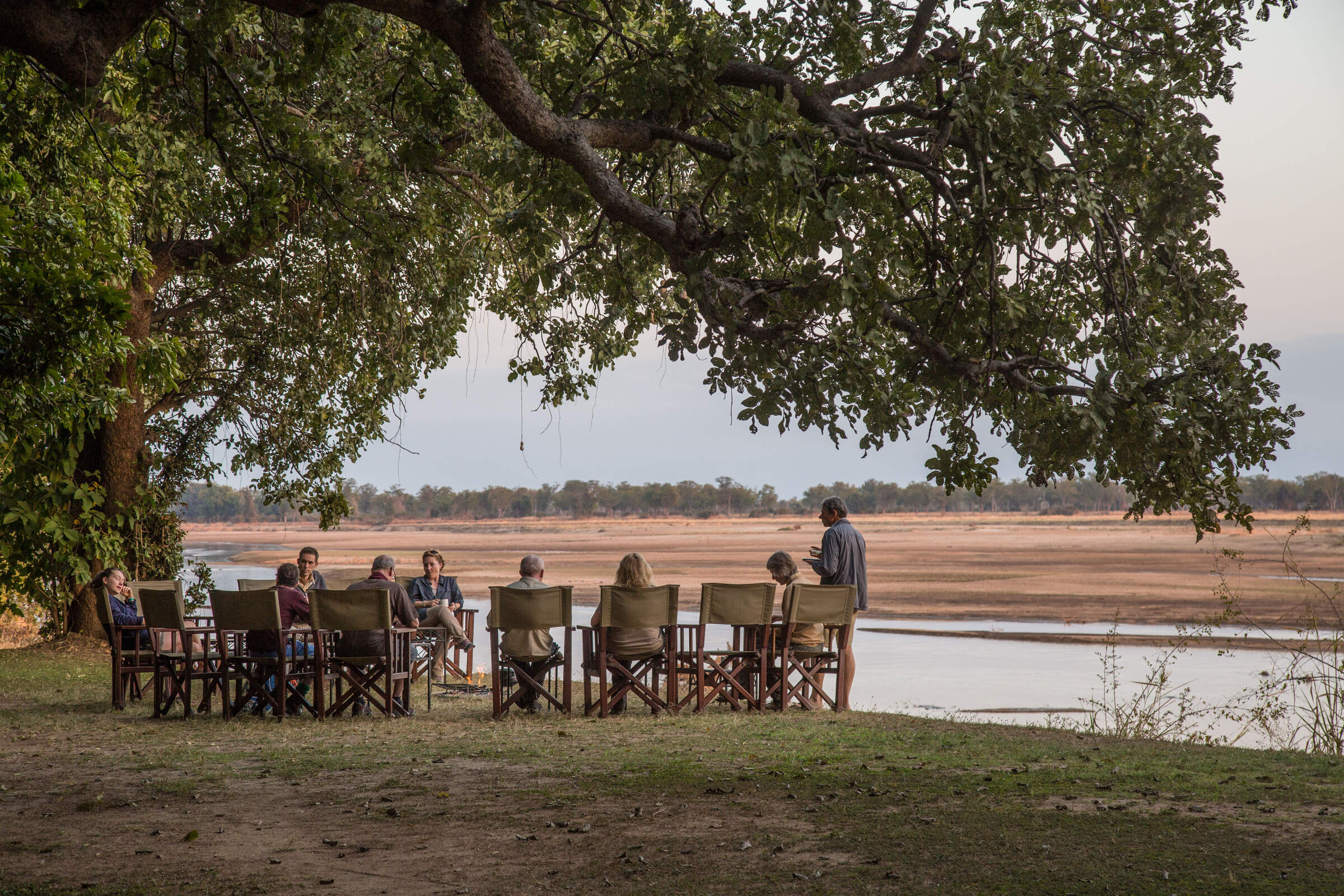
Tafika
One of the best camps in Zambia, Tafika is naturally built, combining excellent service and food with top guiding skills for a superb wildlife experience.
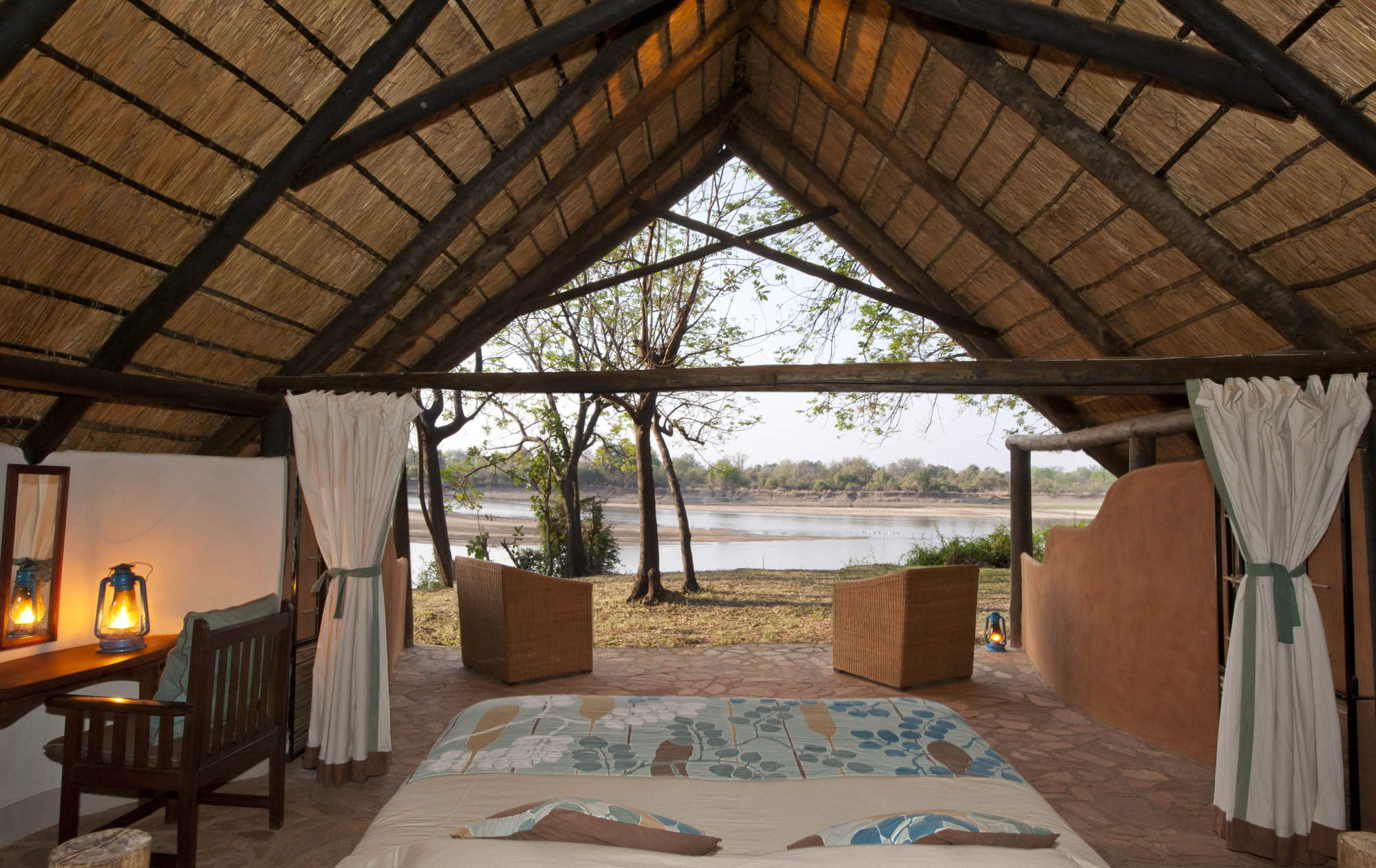
Nkwali
On the banks of the Luangwa River, with its own access to the national park, the intimate Nkwali is open year round.
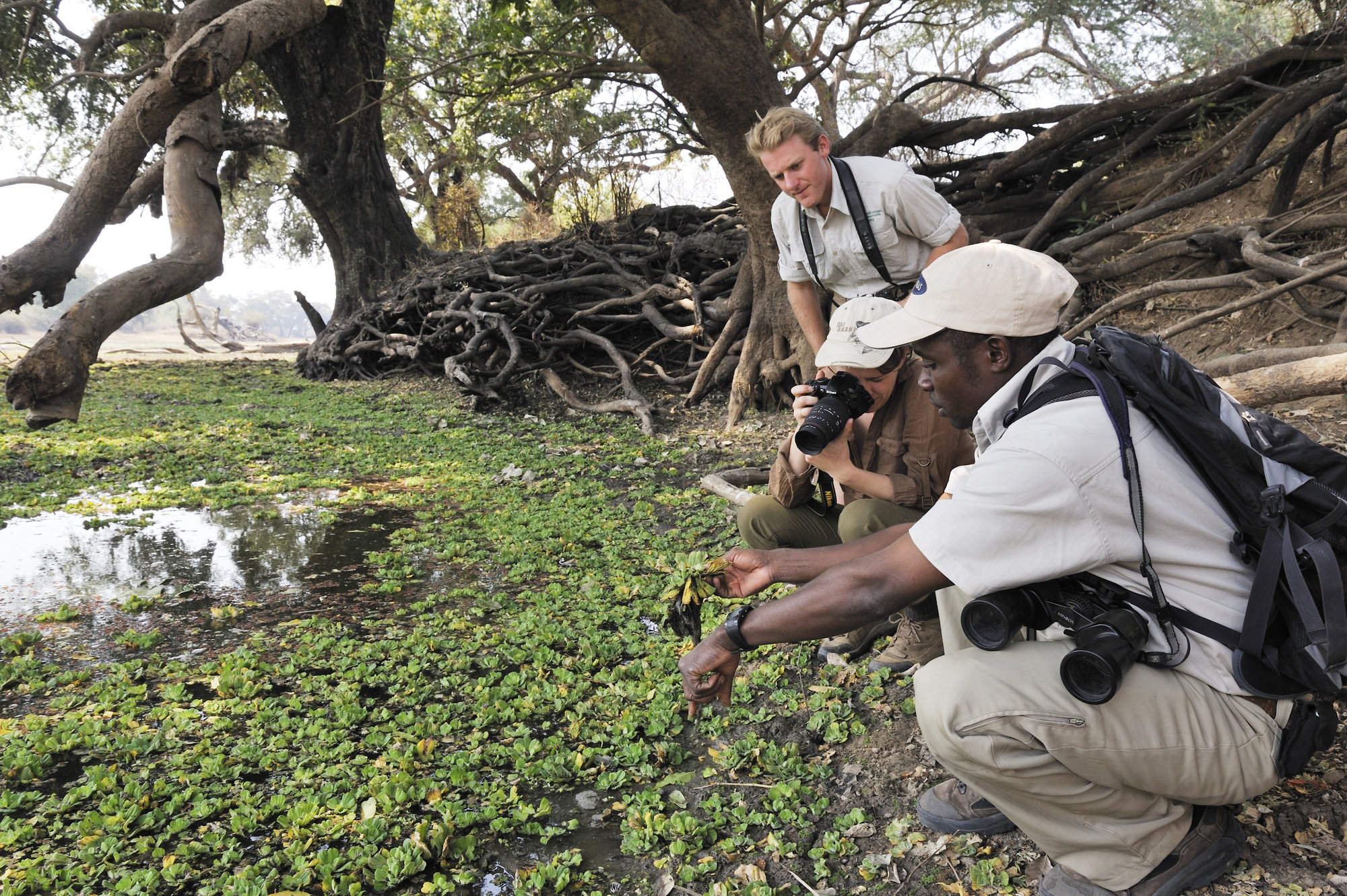
Kaingo Camp
Small and owner-run, the riverside Kaingo occupies a a quiet but excellent game area, with a series of wildlife hides and a focus on photography.
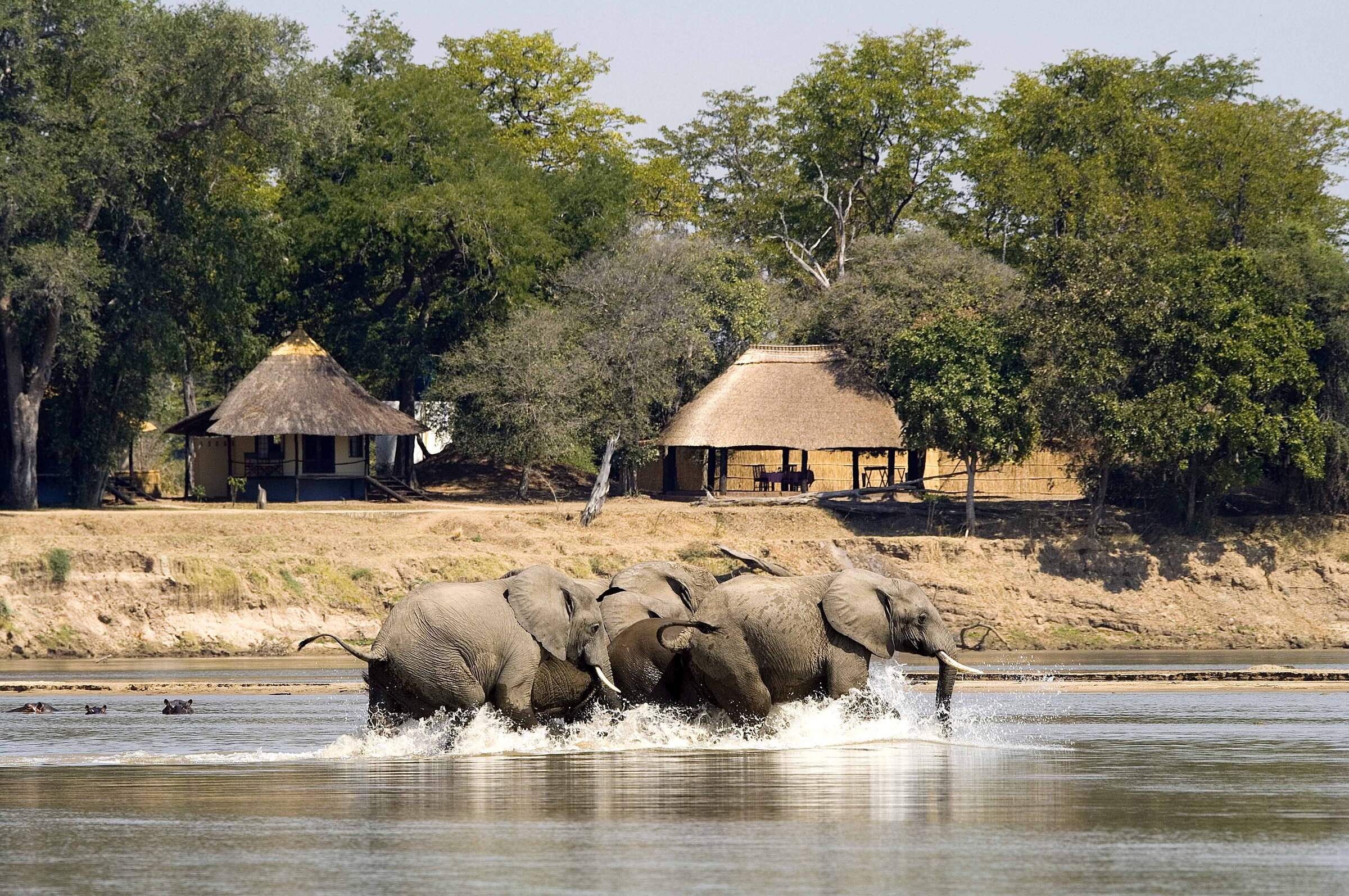
Nsefu
One of the Luangwa's oldest camps, Nsefu is a great safari camp in a remote, beautiful and game-rich location with top-rate guiding.
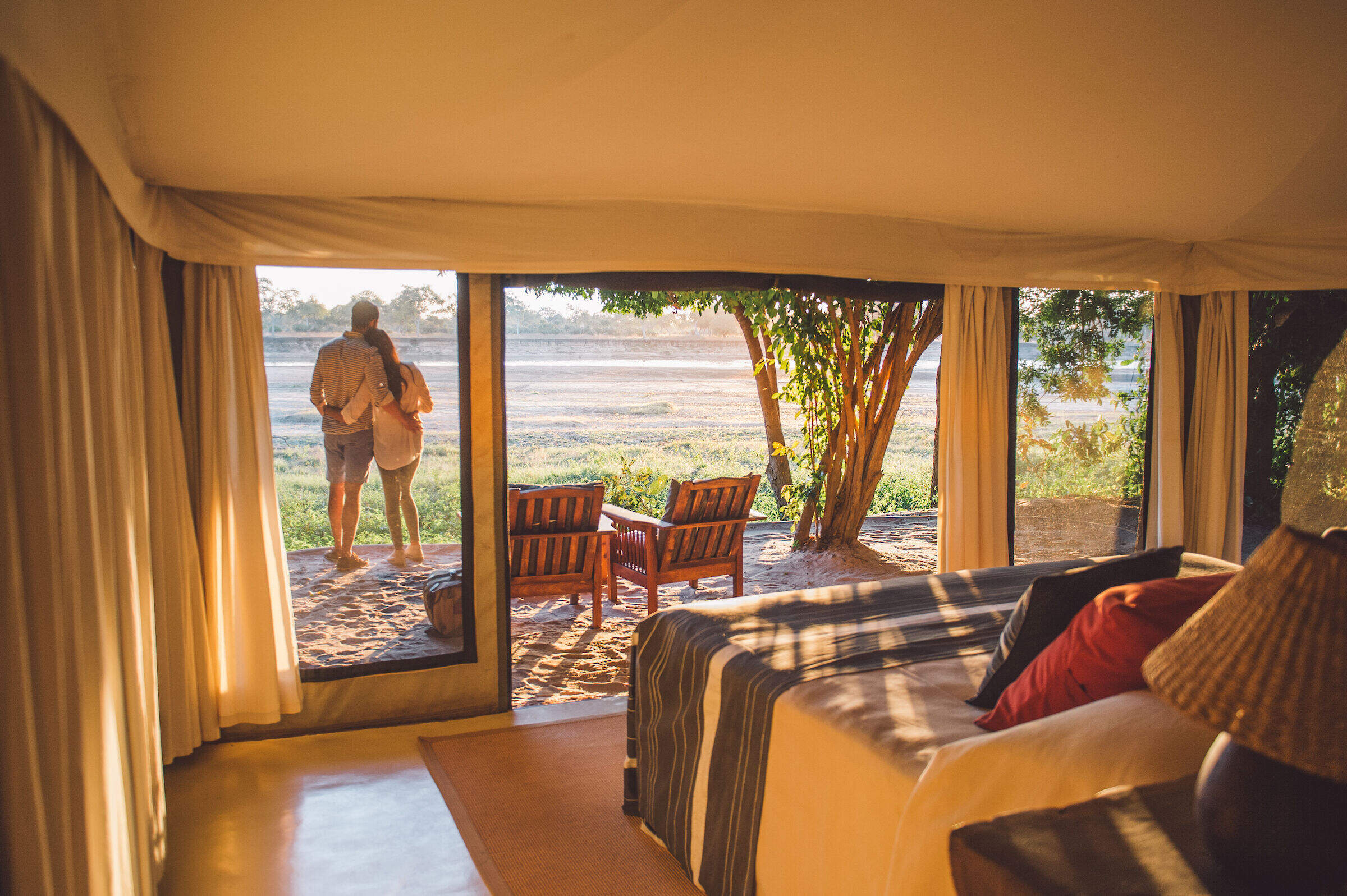
Tena Tena
One of the Luangwa's best camps, in a beautiful, remote bush location, Tena Tena is very small, exceedingly well-run and has top-rate guiding.
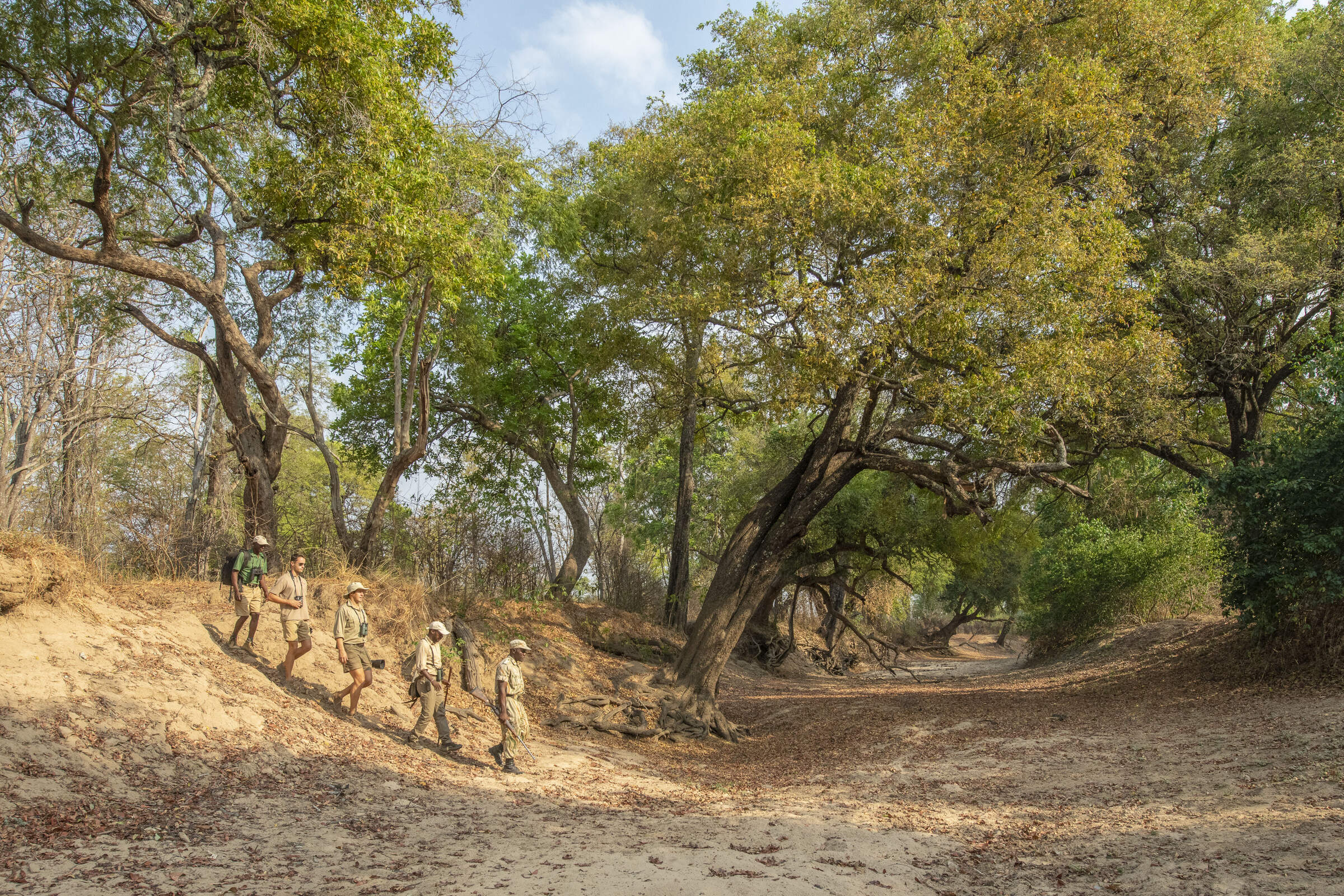
Chikoko Tree Camp
Chikoko Tree Camp is an excellent small, rustic bushcamp that concentrates on walking safaris, and is run by a top-quality operation.
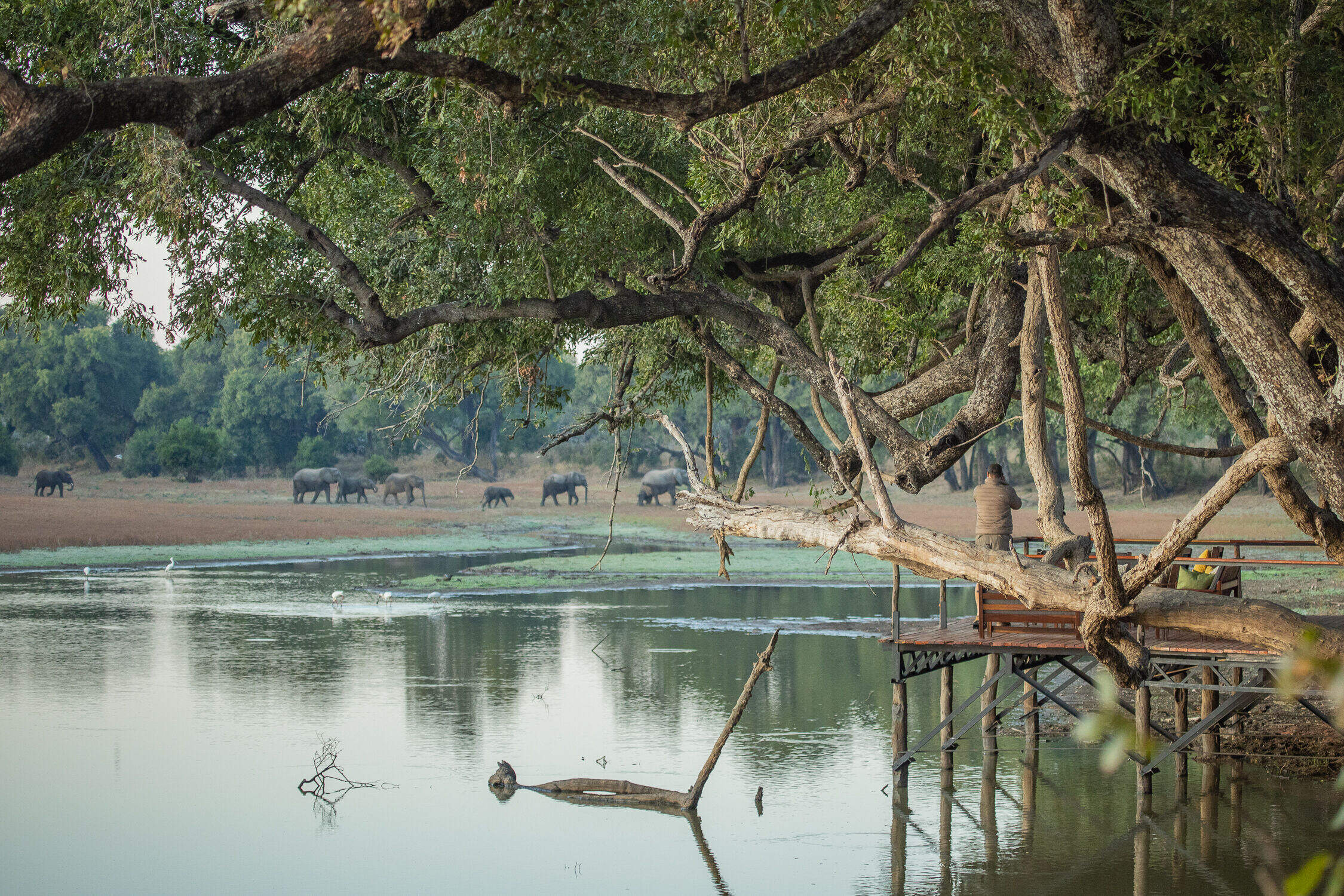
Big Lagoon Camp
Big Lagoon Camp is a great little rustic bushcamp built to high standards that focuses on excellent walking safaris, with the emphasis on top wildlife guides.
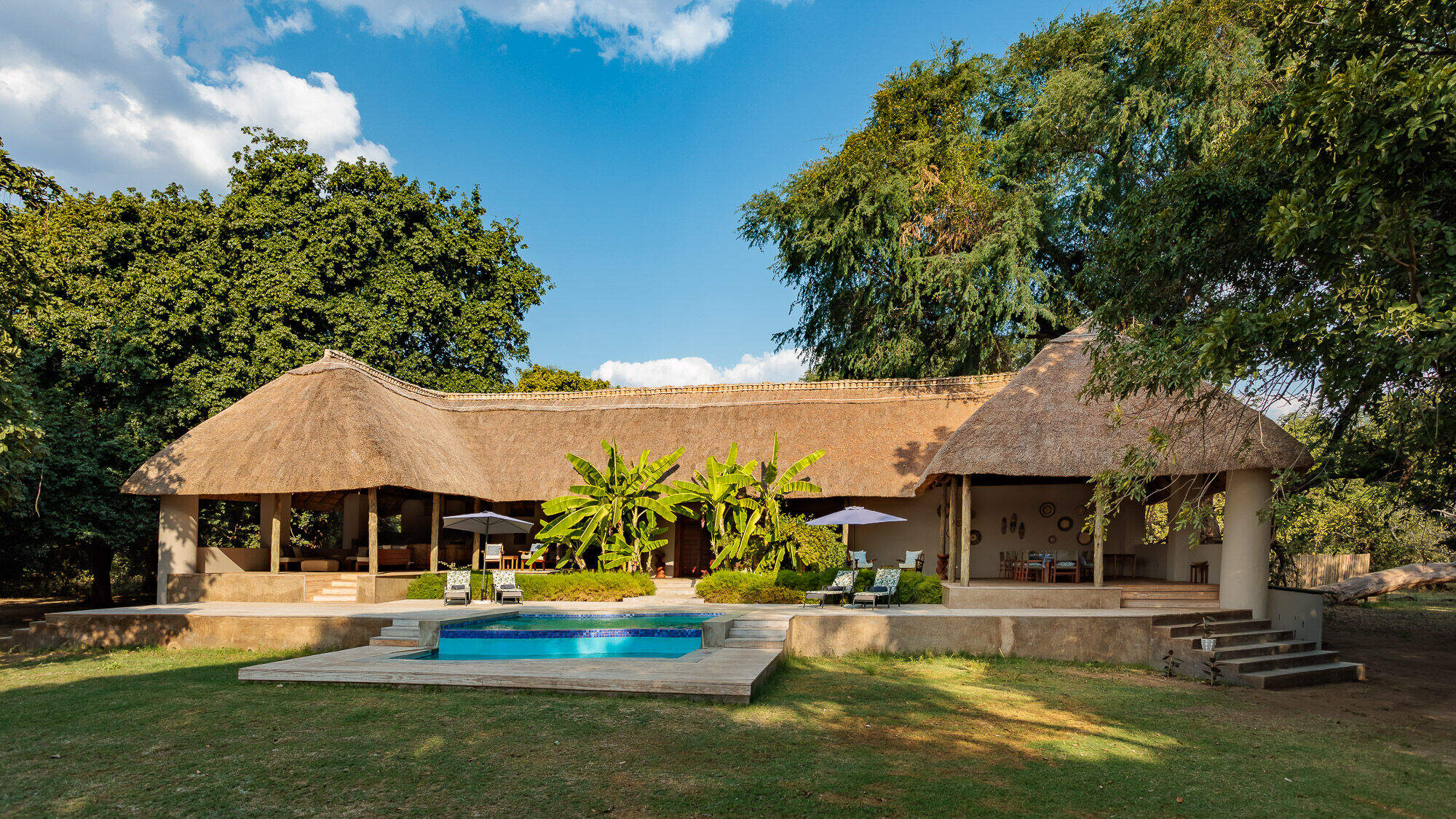
Luangwa River Camp
Luangwa River Lodge is a small and consciously stylish lodge in the Mfuwe area, overlooking the Luangwa River and the South Luangwa National Park beyond – an area renowned for great game.
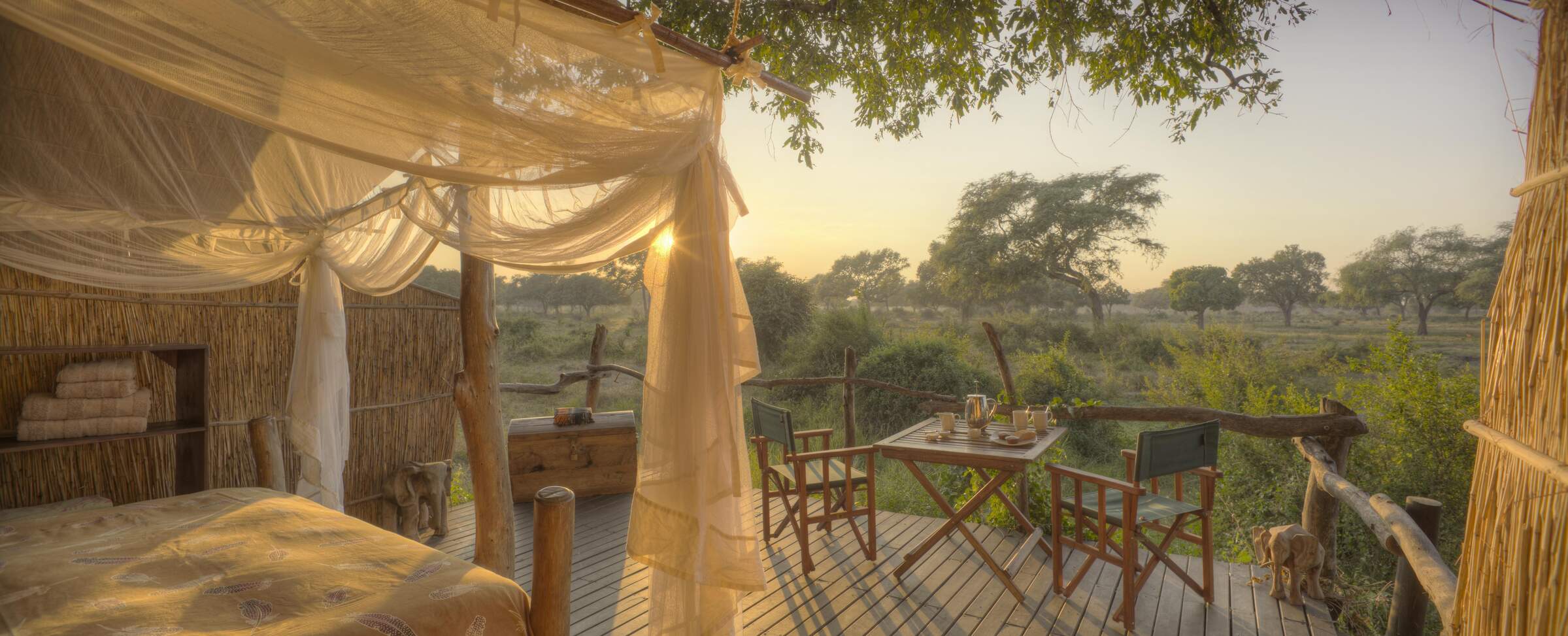
Flatdogs Camp
A relatively big safari camp, Flatdogs offers value for money with great guiding and good food in a comfortable, relaxed setting.
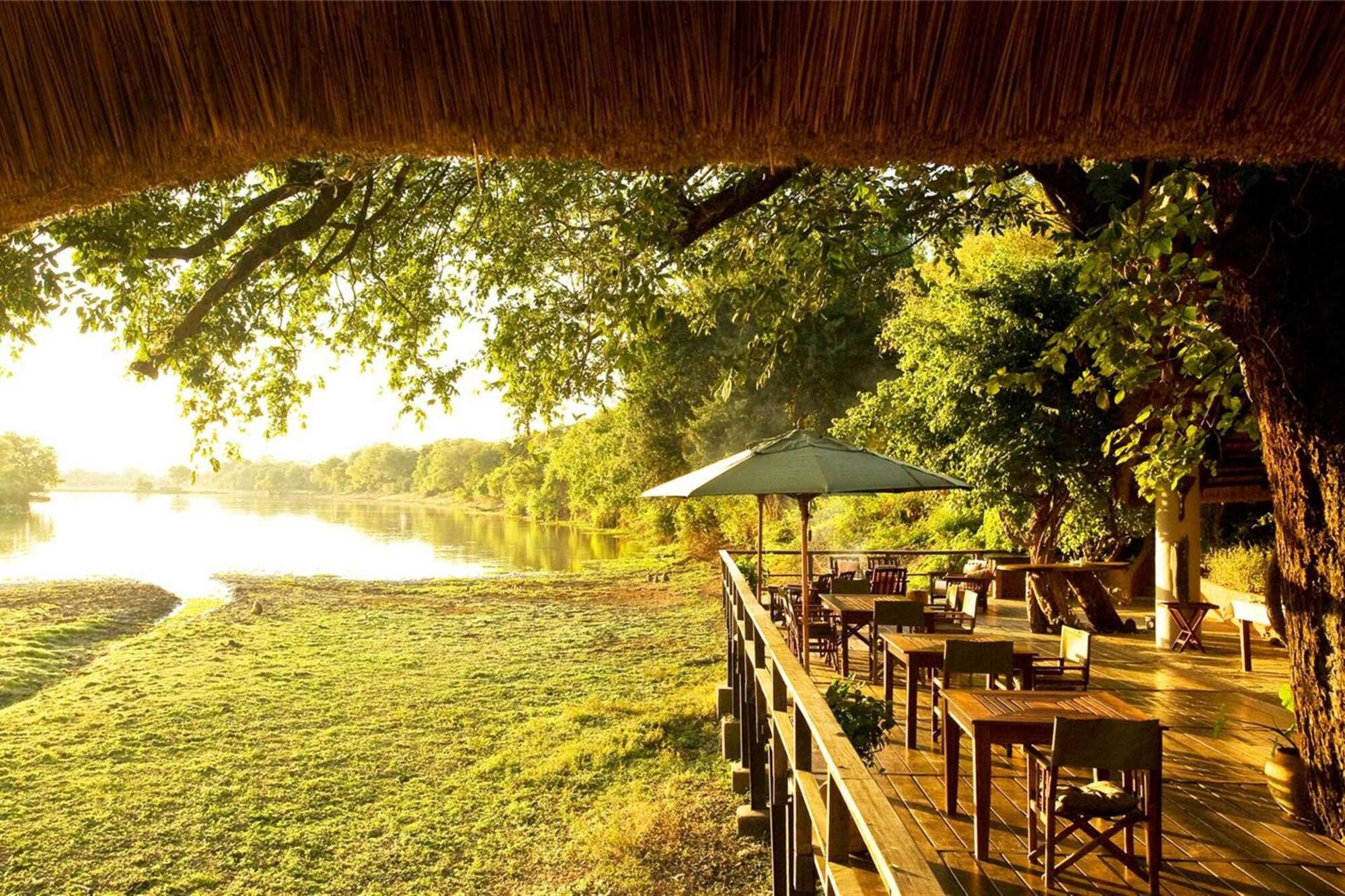
Kapani Lodge
Kapani Lodge is now the main office base for Norman Carr Safaris, one of the Luangwa's oldest safari operations.
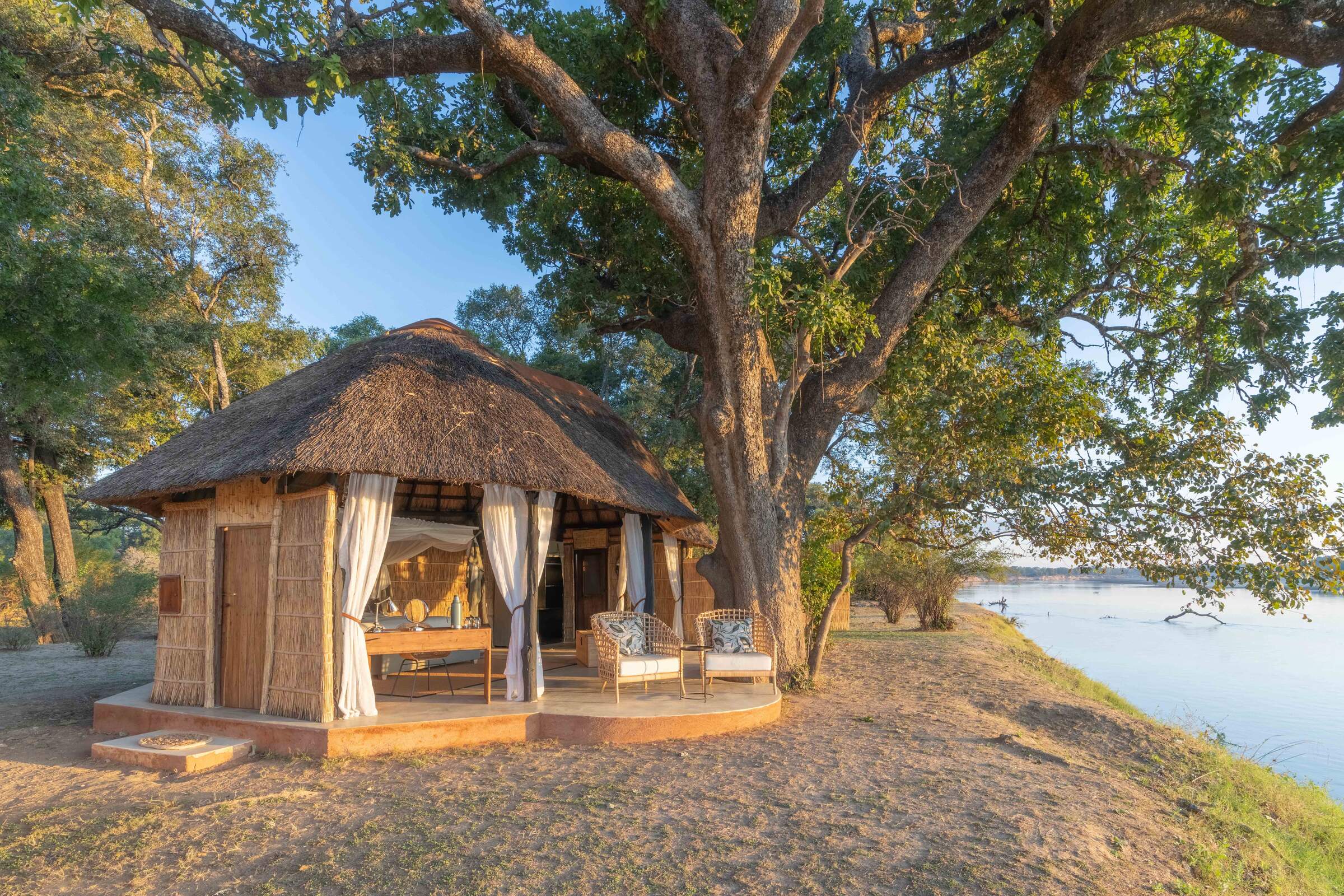
Mchenja Bushcamp
Set in a shady ebony grove on the banks of the Luangwa, Mchenja is a smart tented bushcamp. It combines well with Kakuli and Nsolo – its sister camps with a focus on walking safaris.
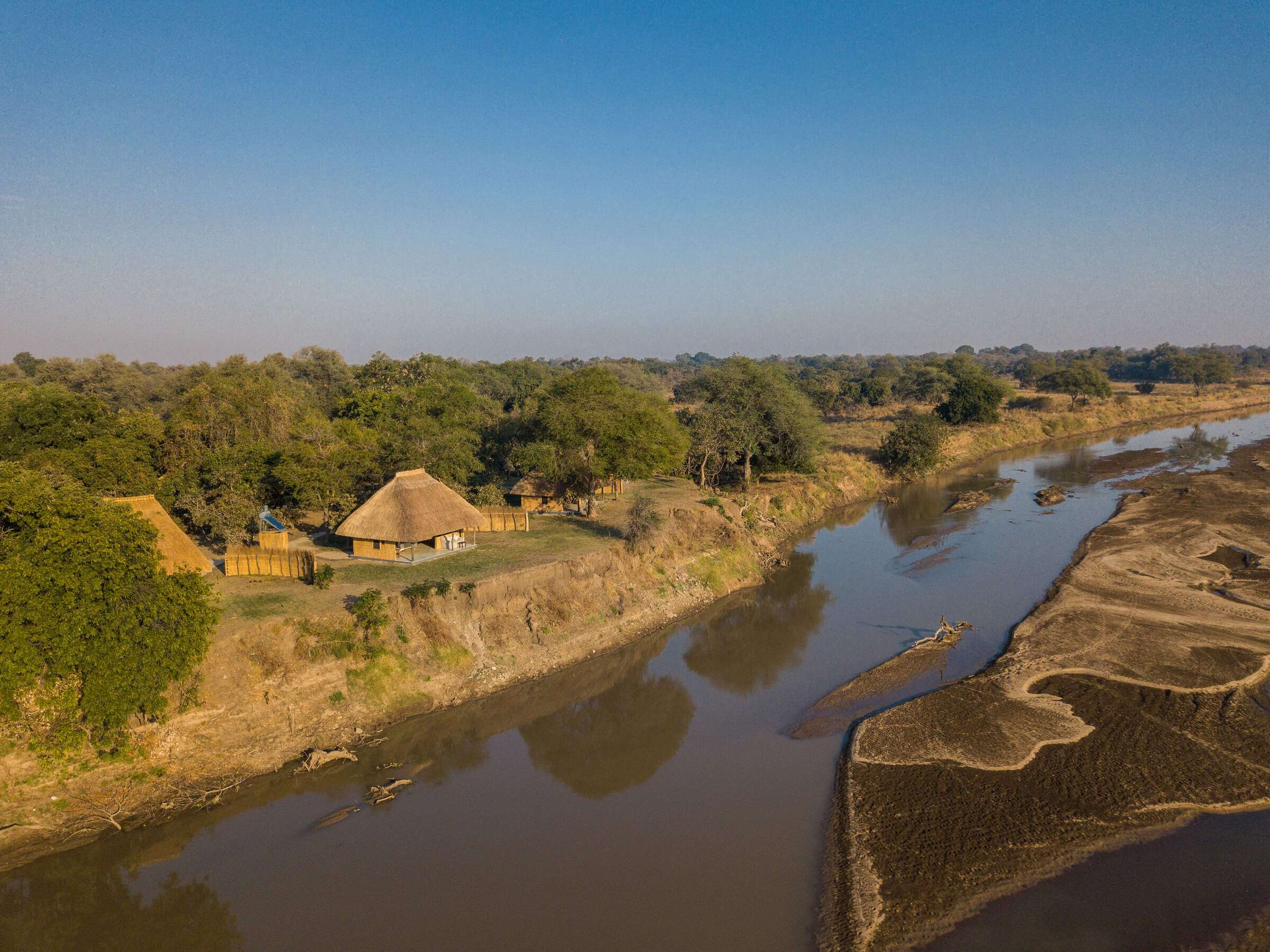
Kakuli Bushcamp
Beside the Luangwa River, Kakuli is a comfortable tented bushcamp offering 4WD safaris and walking safaris – the best of which are camp-to-camp walks linking Kakuli with its nearby sister camps.
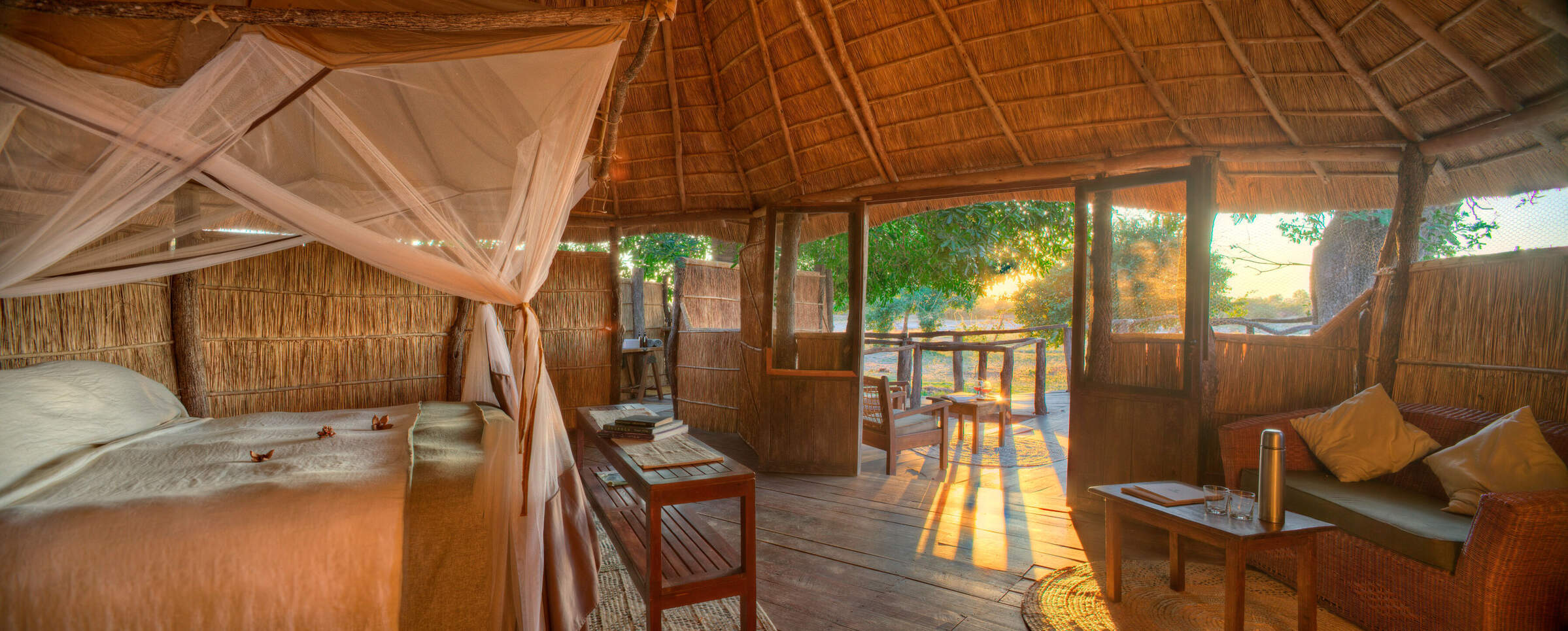
Nsolo Bushcamp
Nsolo is a small, comfortable bushcamp overlooking one or two pools in the usually dry Luwi riverbed. It concentrates on walking safaris in an interesting and diverse area, led by a knowledgeable guide.
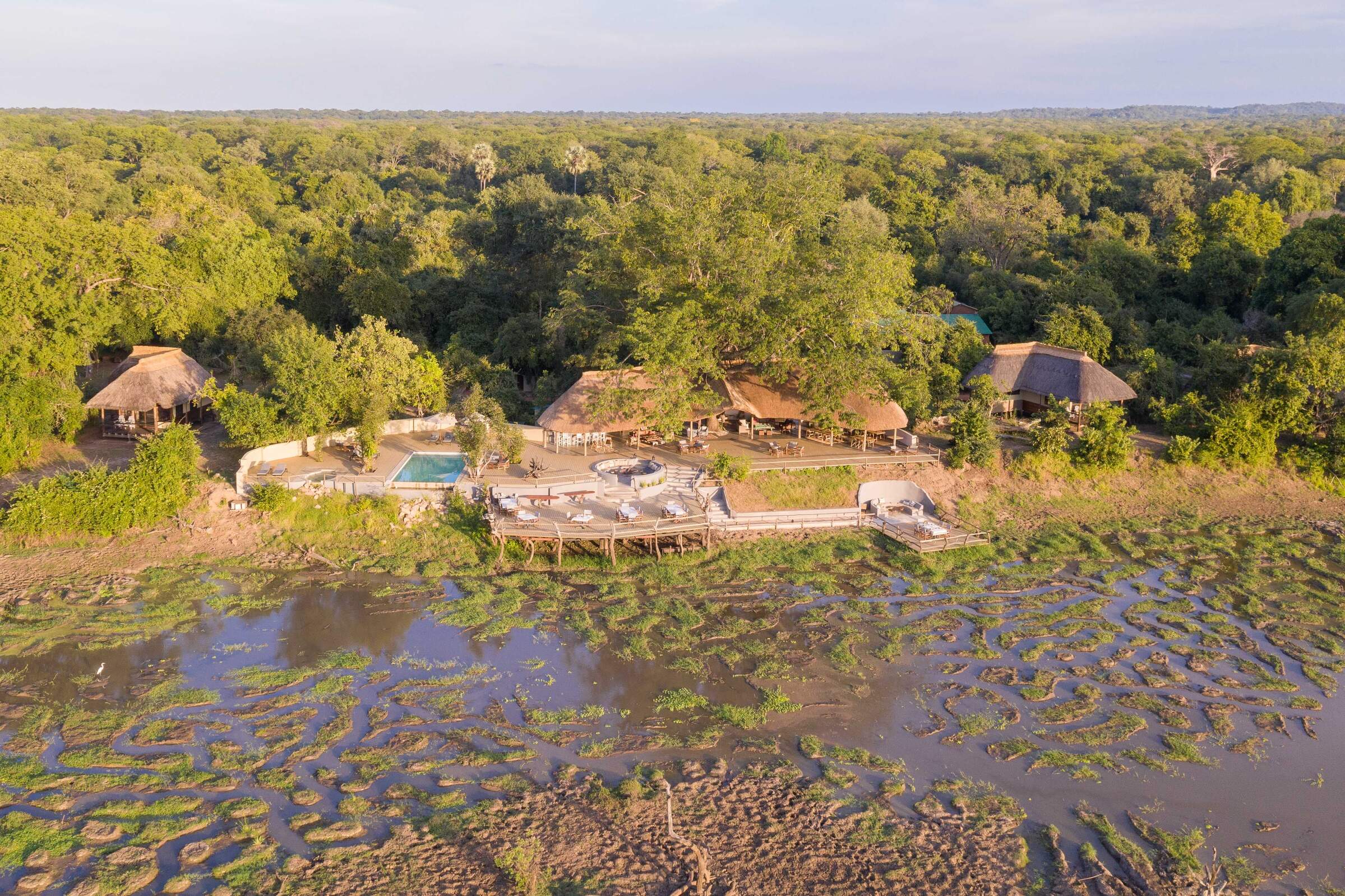
Kafunta River Lodge
Kafunta is a laid-back, friendly and good-value lodge on the outskirts of South Luangwa National Park.
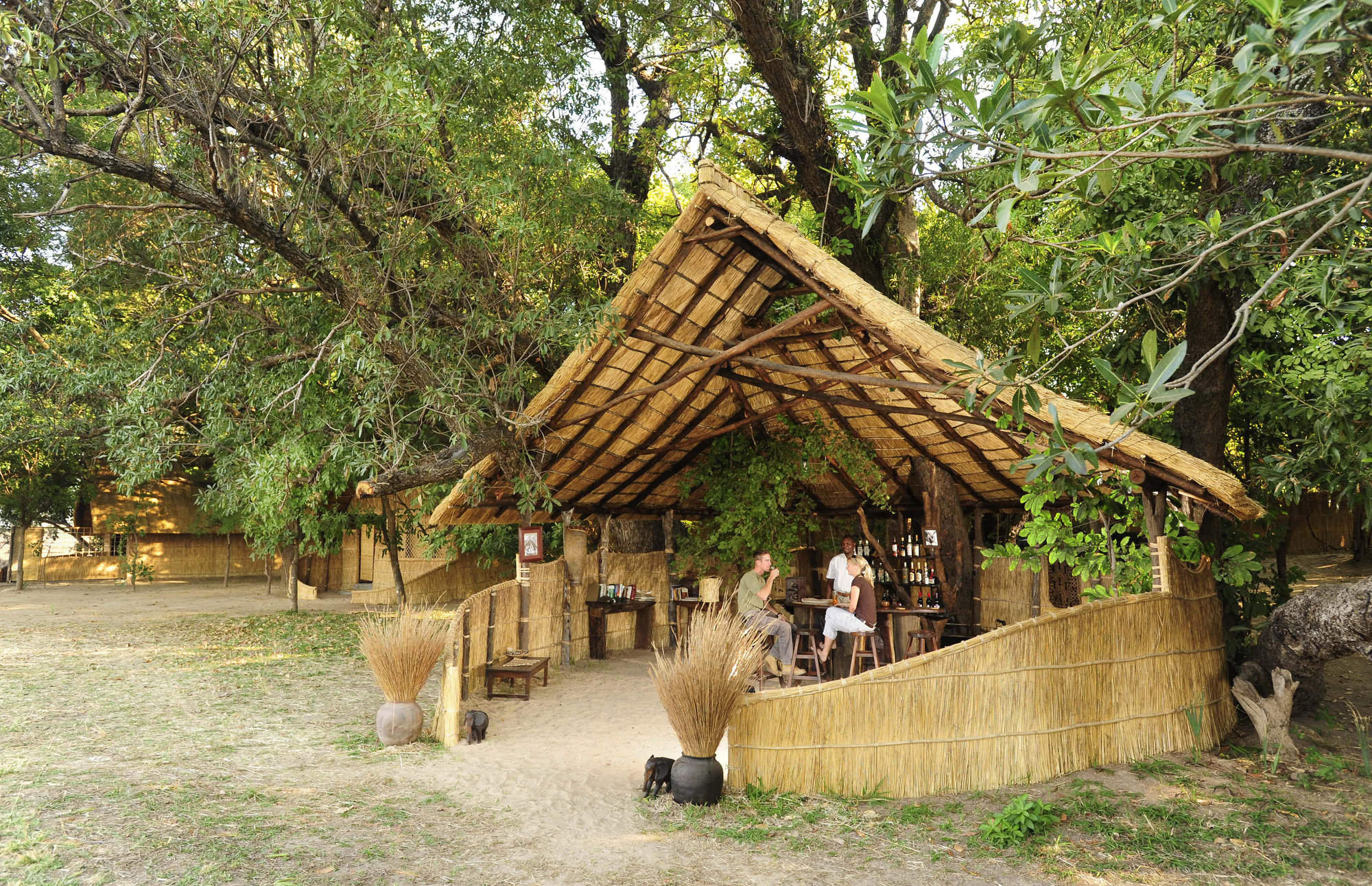
Luwi Bushcamp
In a remote part of the South Luangwa National Park, Luwi is a rustic bushcamp whose emphasis is on walking safaris with great guiding and a chance of seeing some rarely seen and elusive antelope.
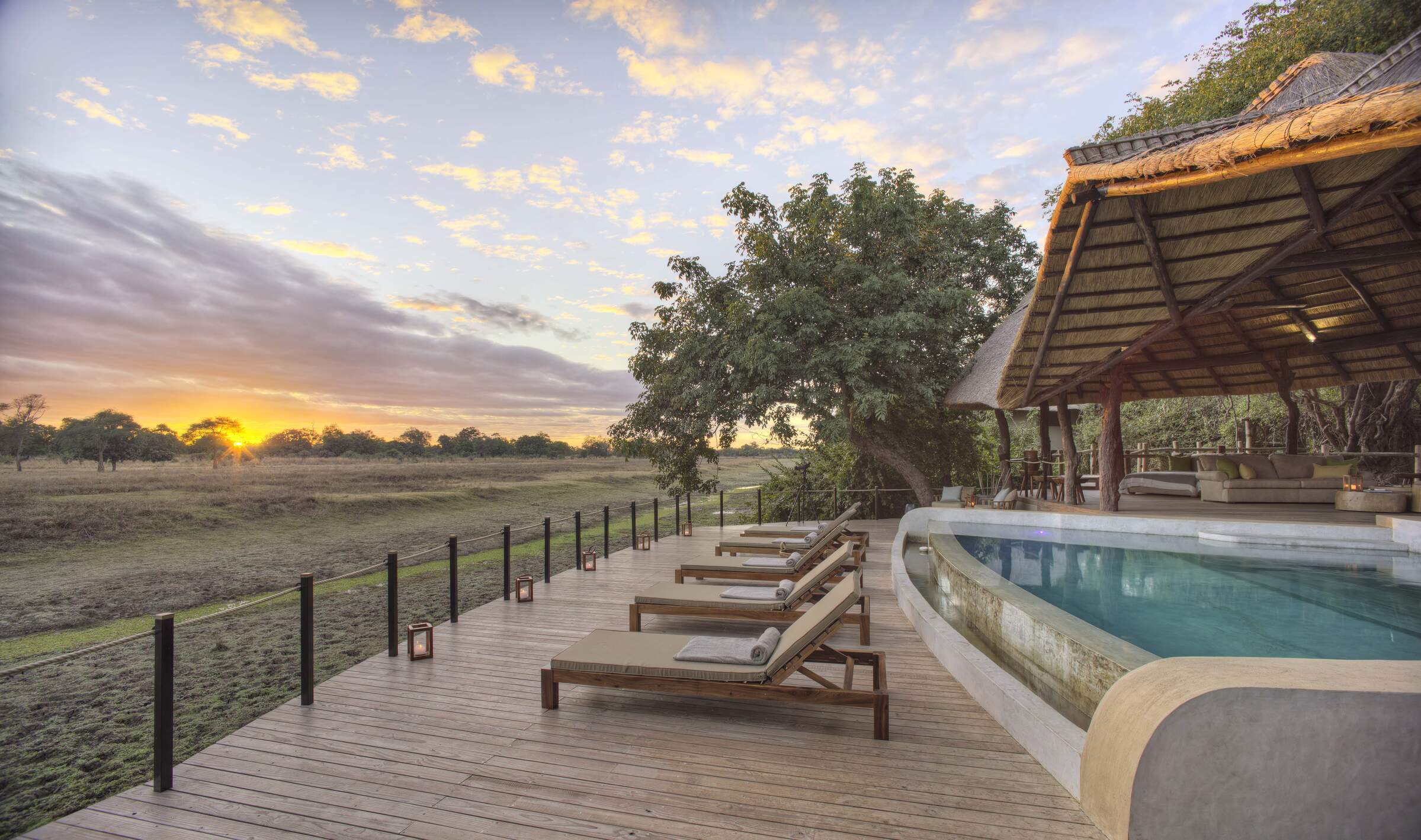
Lion Camp
Lion Camp is an established and comfortable camp with a swimming pool, located near to the game-rich Lion Plain in the northern part of South Luangwa National Park.
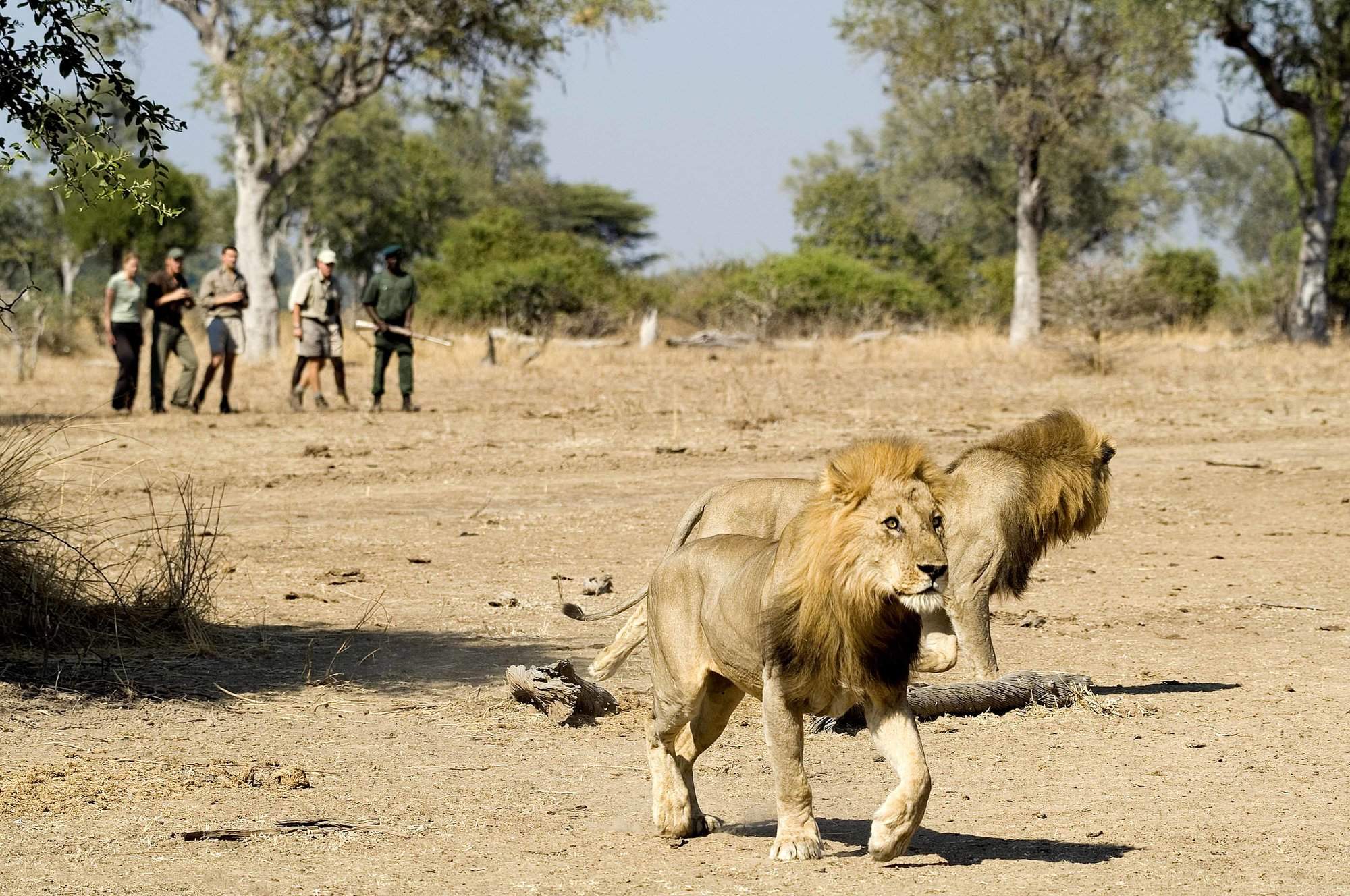
Robin Pope mobile
RPS mobile safari camps are at the heart of their set-itinerary walking safaris in South Luangwa National Park, which start and finish at a permanent camp.
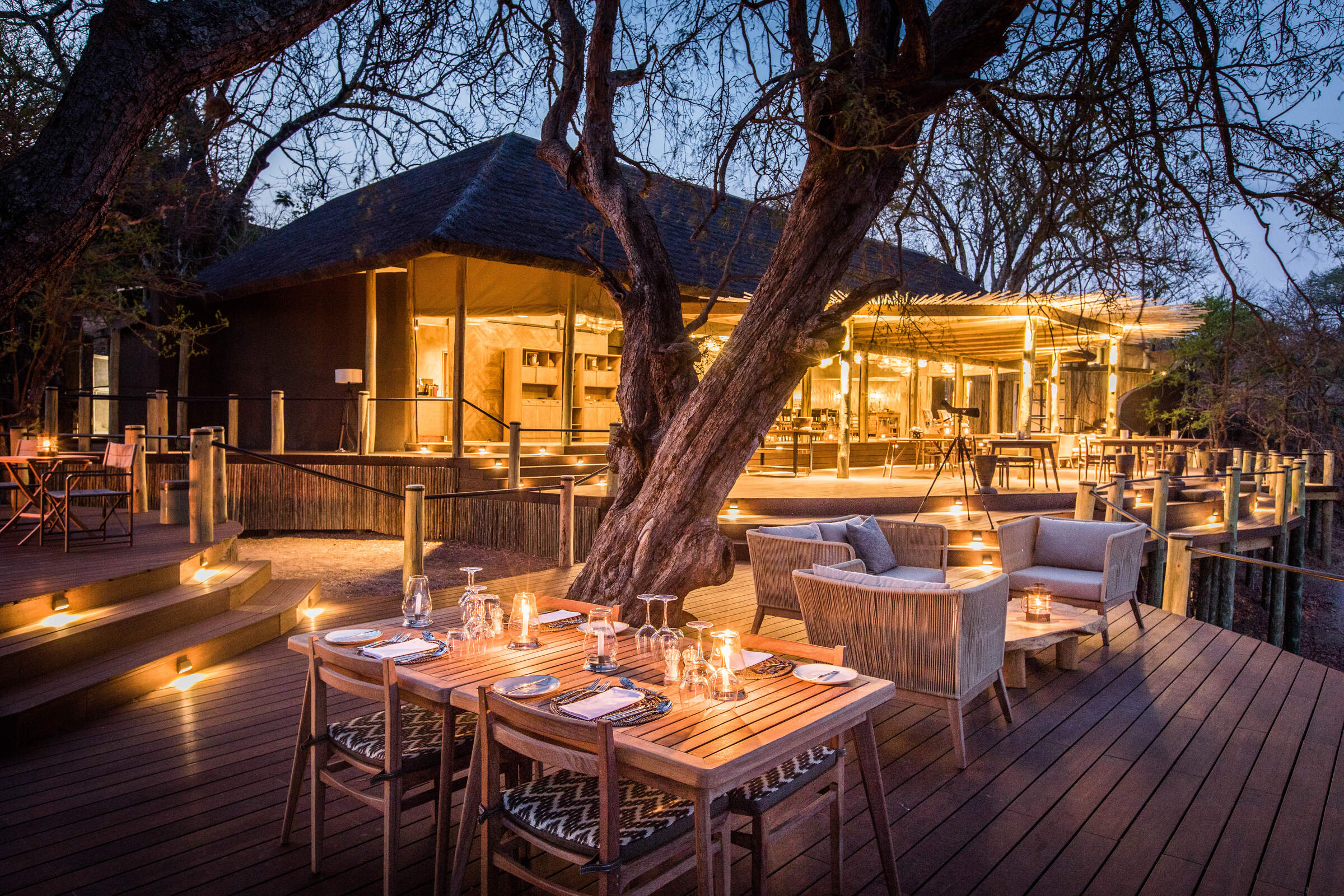
Puku Ridge
Puku Ridge is a luxurious designer camp set in a stunning location, high on a hill overlooking a floodplain within South Luangwa. Explore from here on 4WD safaris and walks.
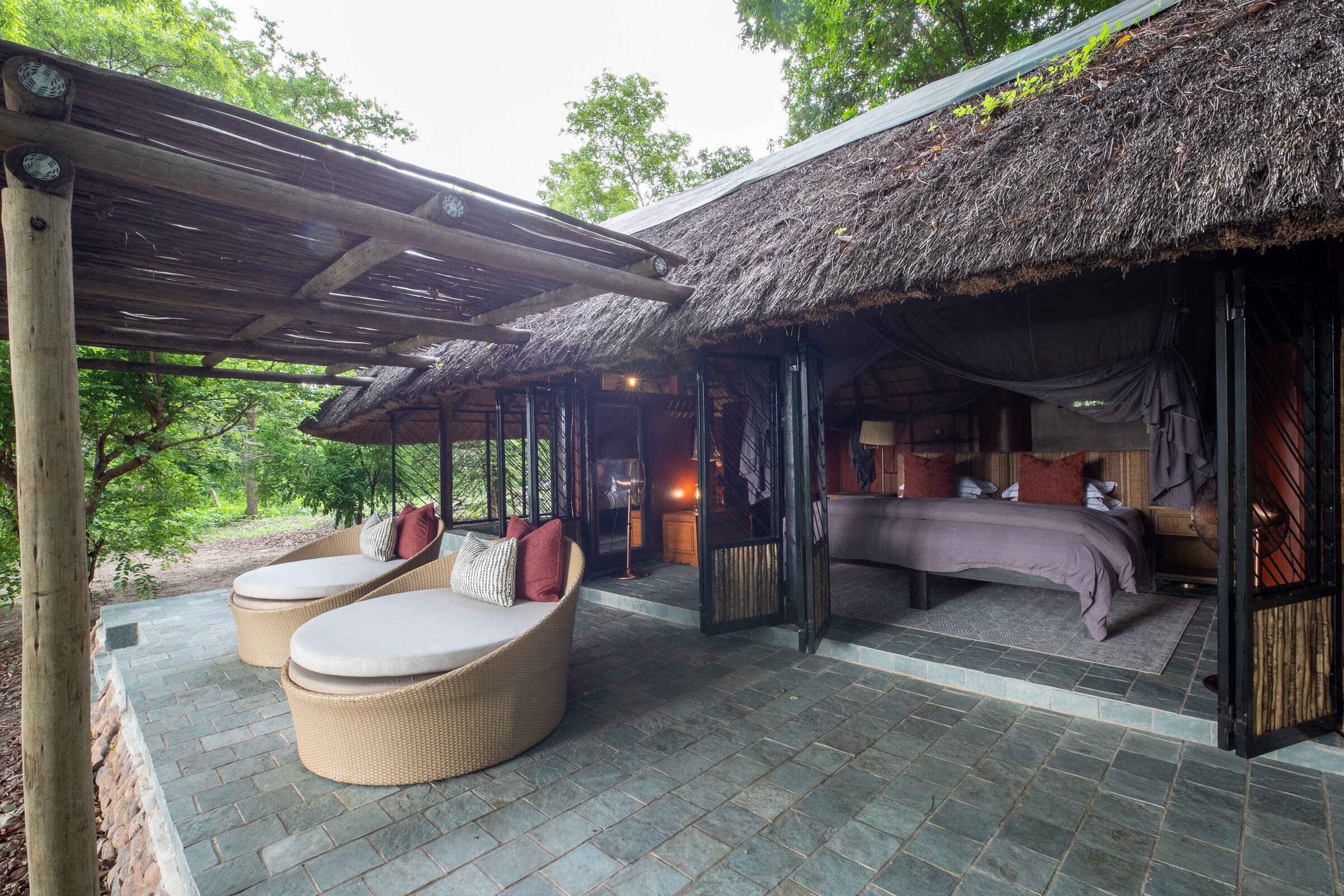
Kapamba Bushcamp
In the remote far south of South Luangwa National Park, Kapamba is a small and very comfortable bushcamp offering good walks and game drives.
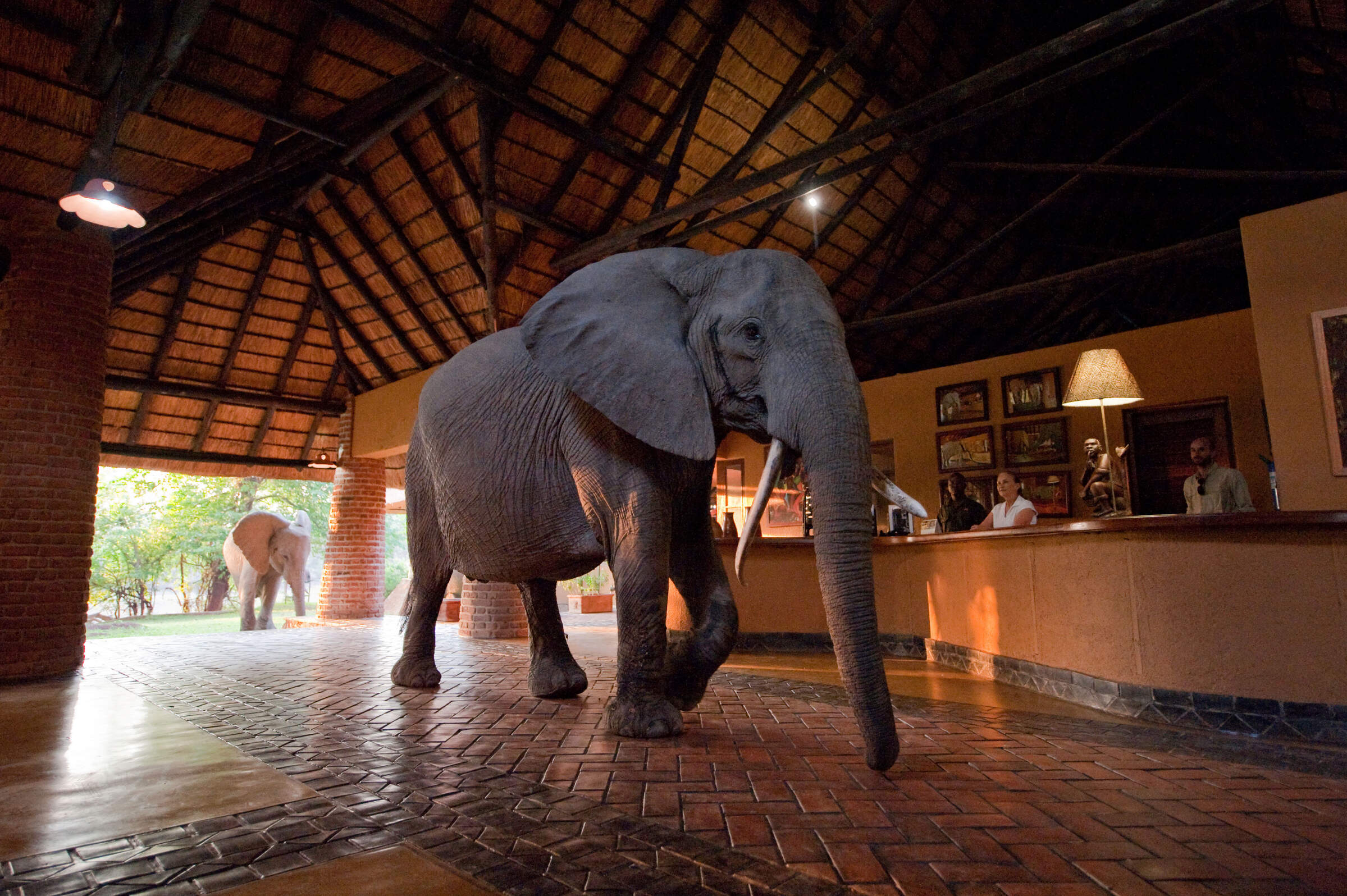
Mfuwe Lodge
In a game-rich area close to the South Luangwa’s main Mfuwe Gate, Mfuwe Lodge is relatively large by park standards, but it’s stylish, modern and family friendly.
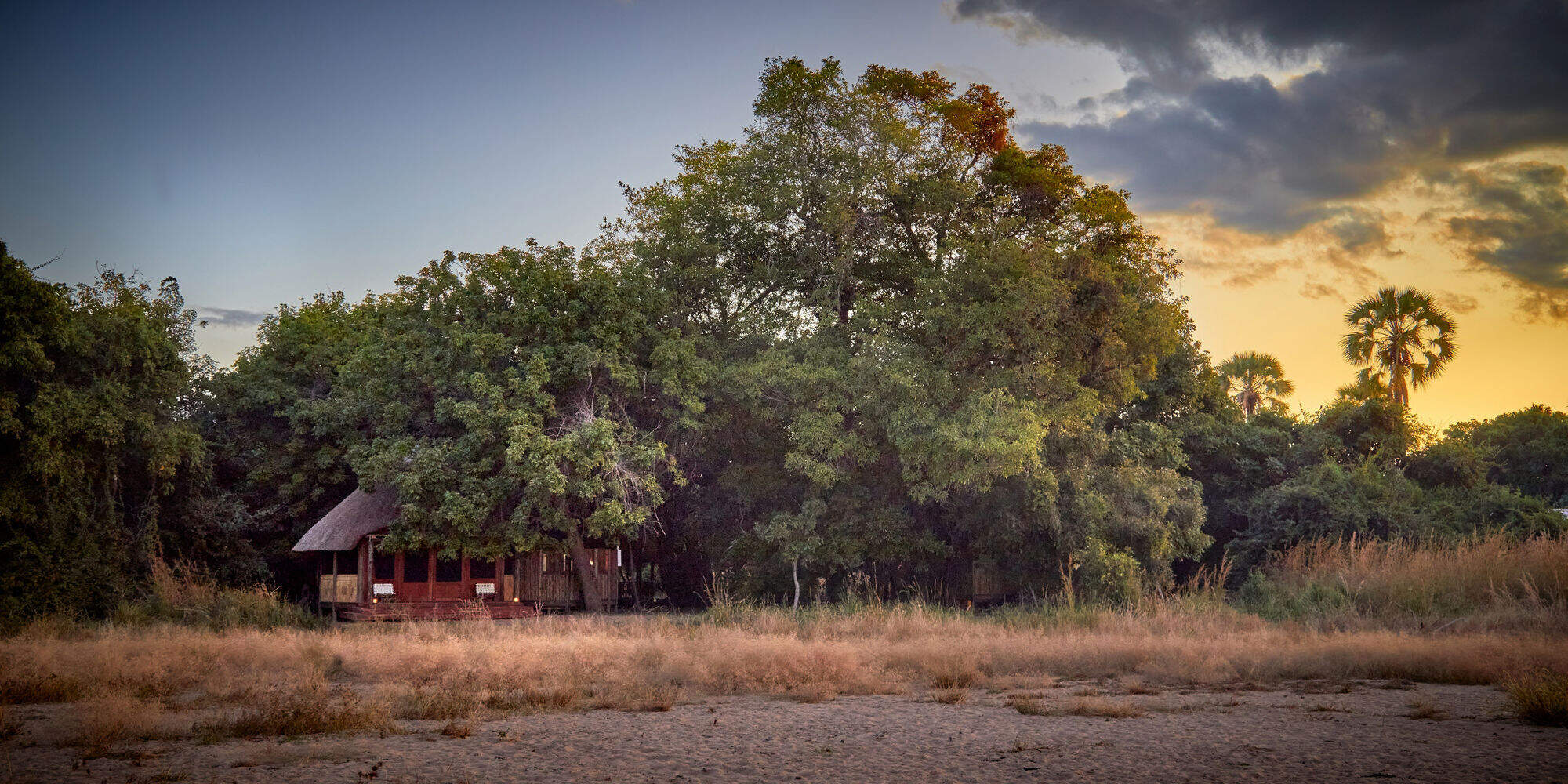
Kuyenda Bushcamp
Kuyenda Bushcamp is a classic bushcamp with particularly delightful hosts and offers top-class walking safaris in South Luangwa National Park.
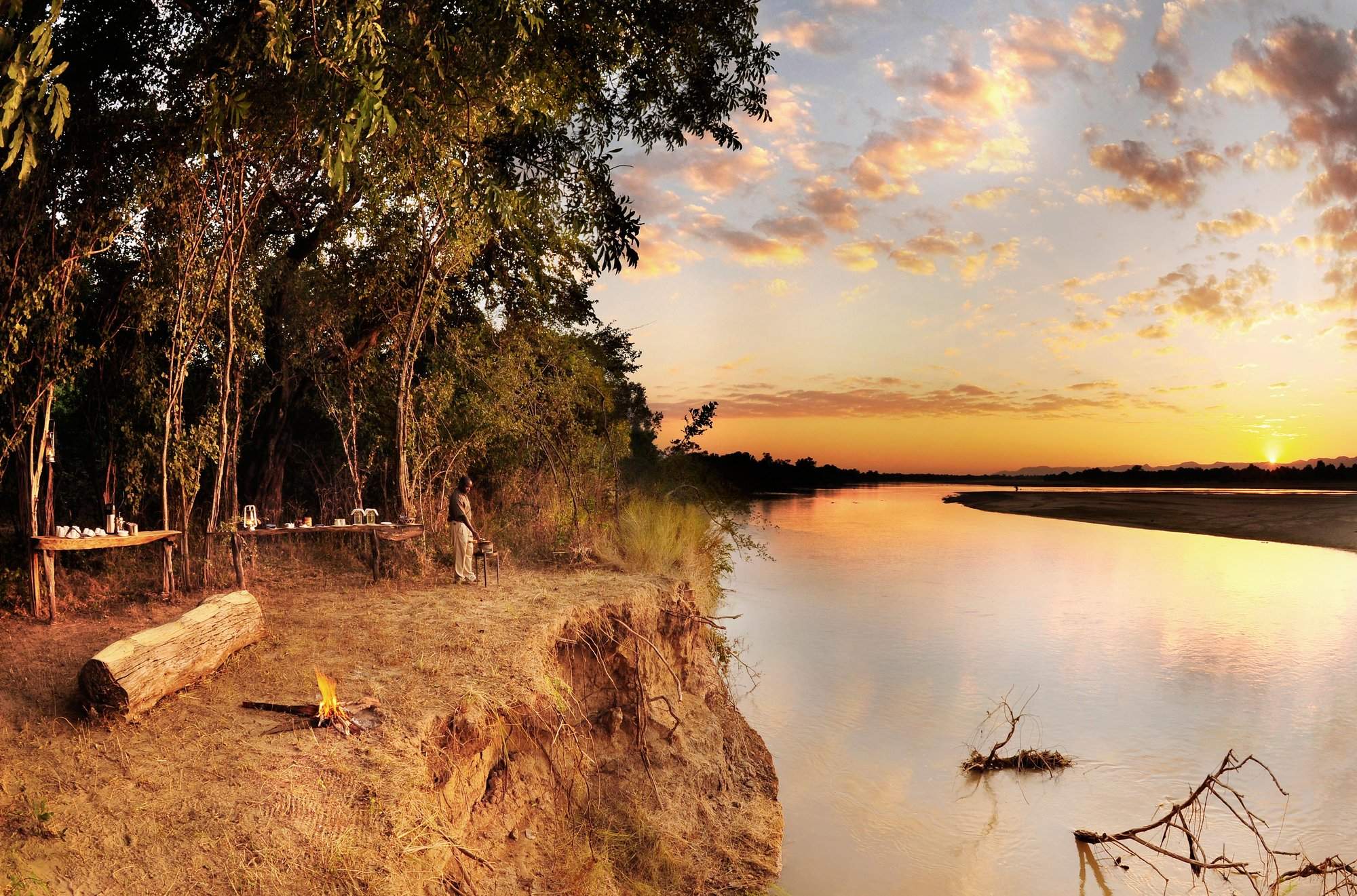
Bilimungwe Bushcamp
A smart bushcamp with four very spacious chalets, Bilimungwe offers interesting walking safaris in pretty riverine woodland, as well as day and night safari drives.
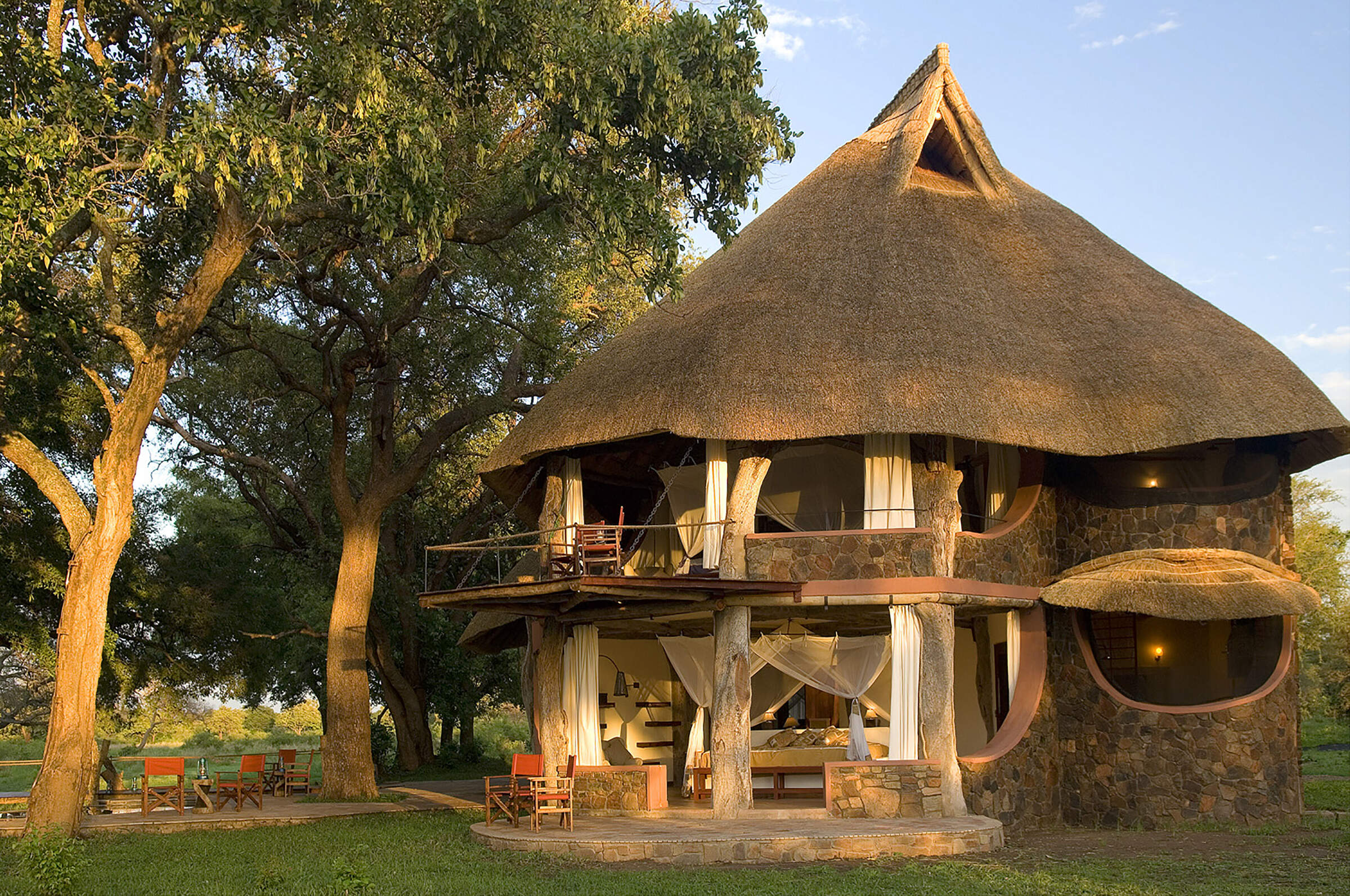
Luangwa Safari House
Luangwa Safari House is a vast and very smart four-bedroom house specifically designed for families and small groups, and offering an exclusive and flexible safari experience.

Three Rivers Camp
In the remote far south of South Luangwa National Park, Three Rivers Lodge sits at the confluence of three of the valleys rivers.
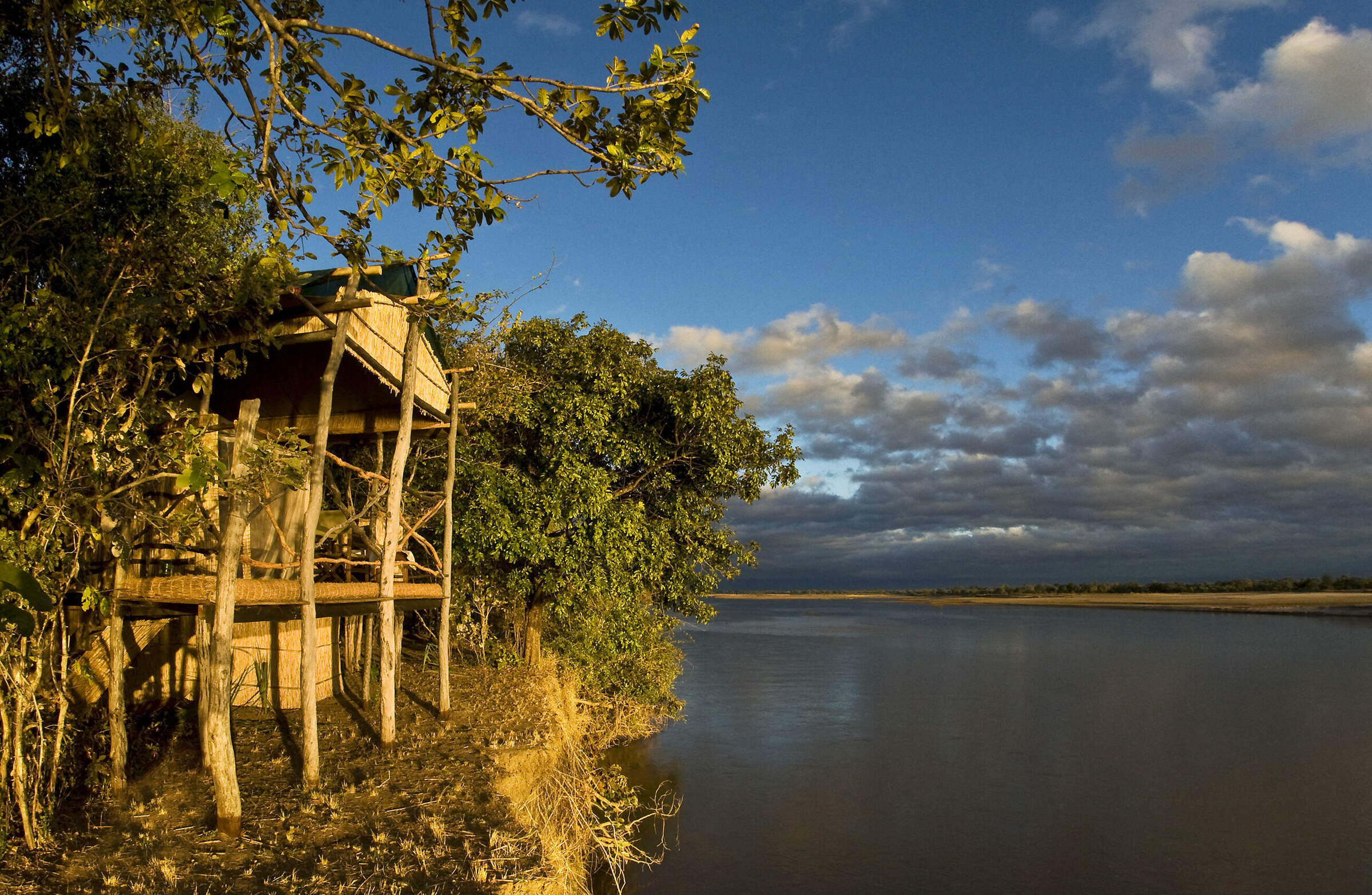
Island Bush Camp
Island Bushcamp is a good-value, rustic, walking-only camp, in arguably one of the most remote parts of the South Luangwa, well away from all other camps.
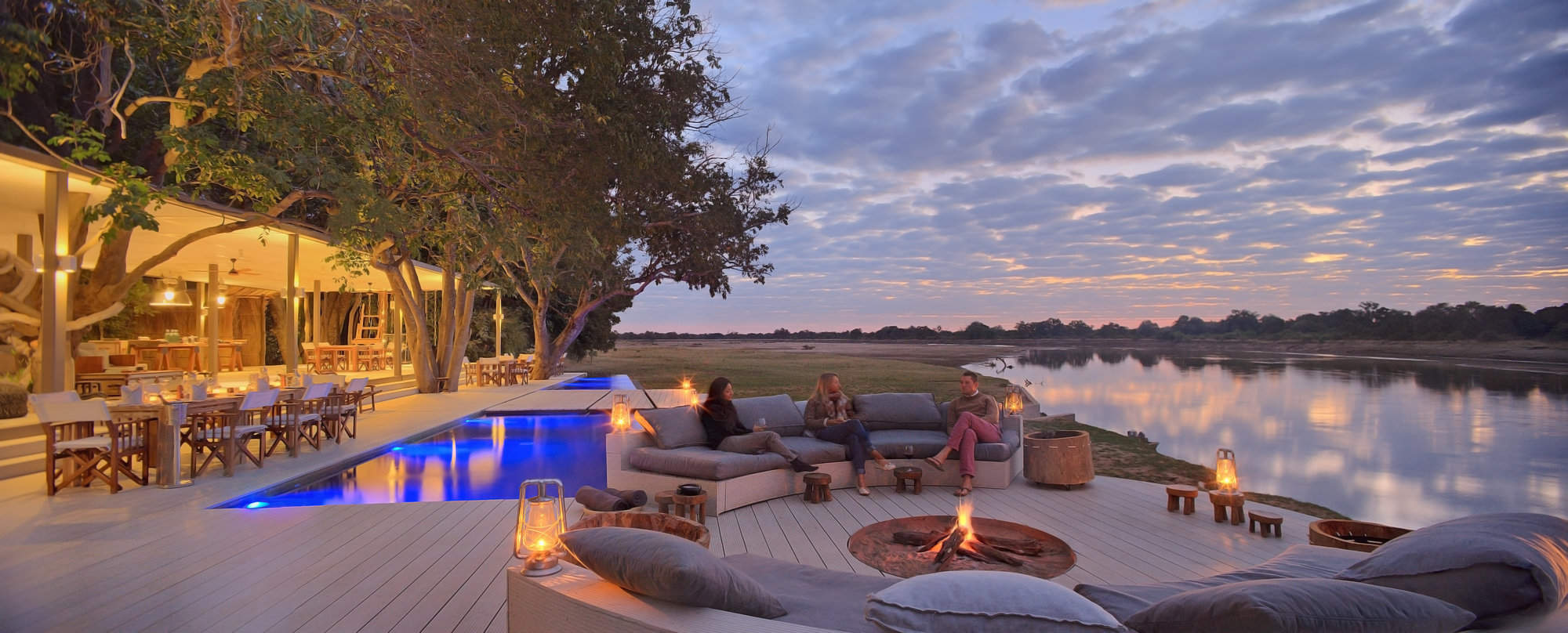
Chinzombo
Opened in early June 2013, Chinzombo offers luxurious and stylish accommodation with very high levels of service and excellent guiding.
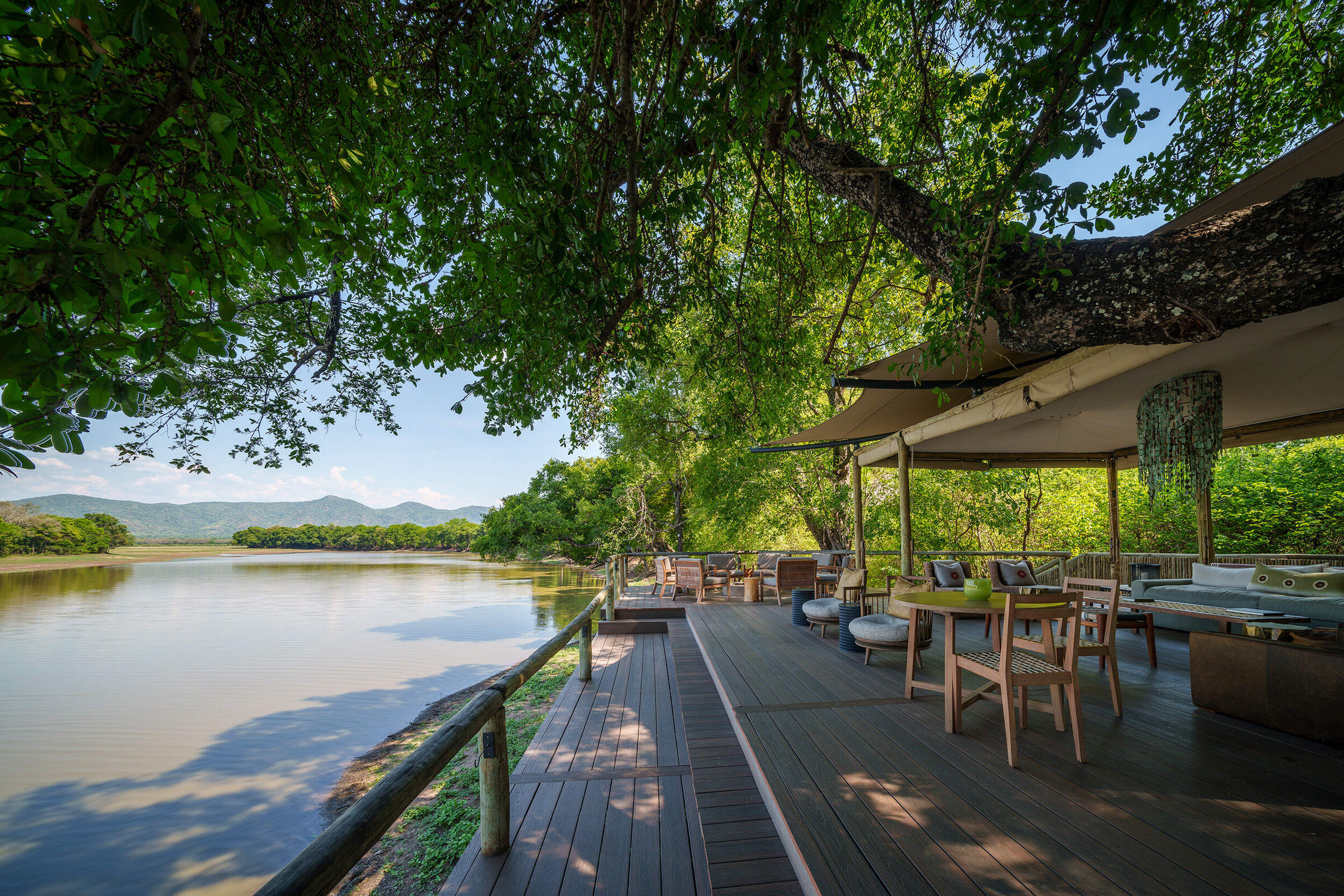
Chindeni
Chindeni Bushcamp is a very modern and minimalist camp, which is a far cry from your traditional bushcamp and unlike most of the other camps in South Luangwa.
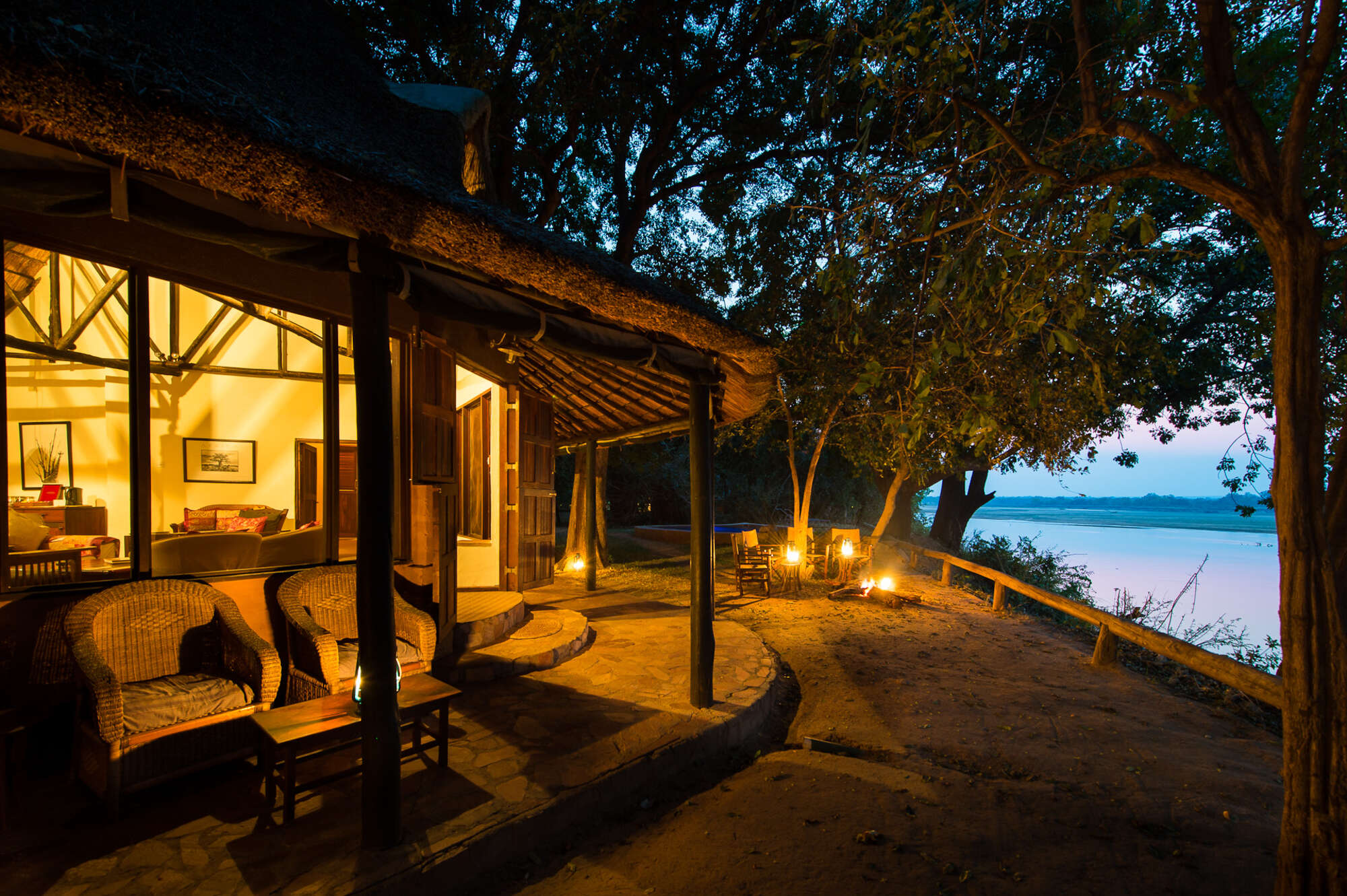
Robin's House
With your own expert guide, private vehicle, chef and valet, the two-bedroom Robin's House offers an exclusive, flexible safari experience – and is open year round.
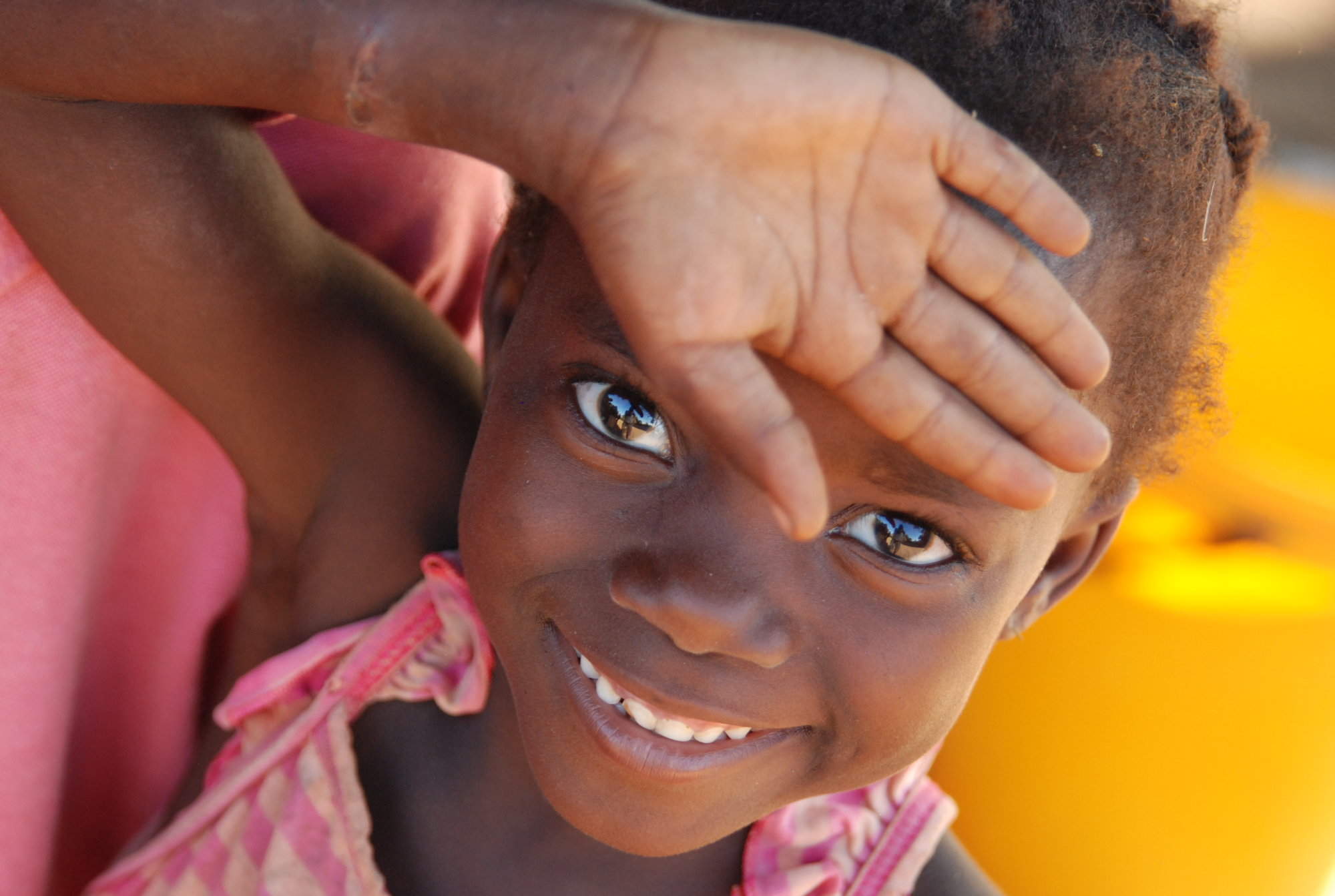
Kawaza Village
Kawaza Village – beside the South Luangwa National Park, offers guests the rare opportunity to appreciate local village life. Visit for a few hours or stay overnight.
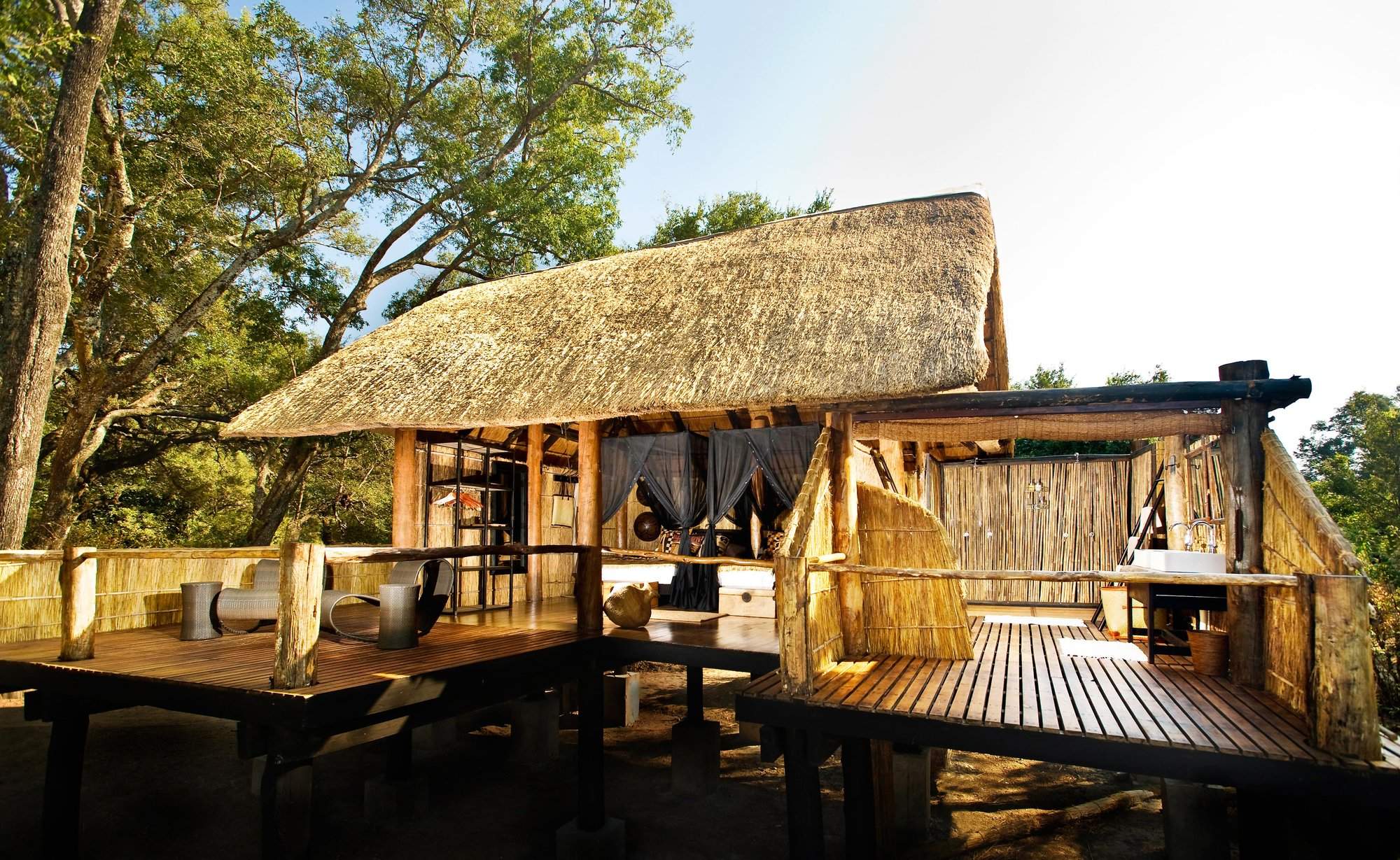
Chamilandu Bushcamp
A comfortable little bushcamp, Chamilandu has a picturesque setting by the Luangwa River, in an area with a range of habitats to explore on foot and by 4WD.
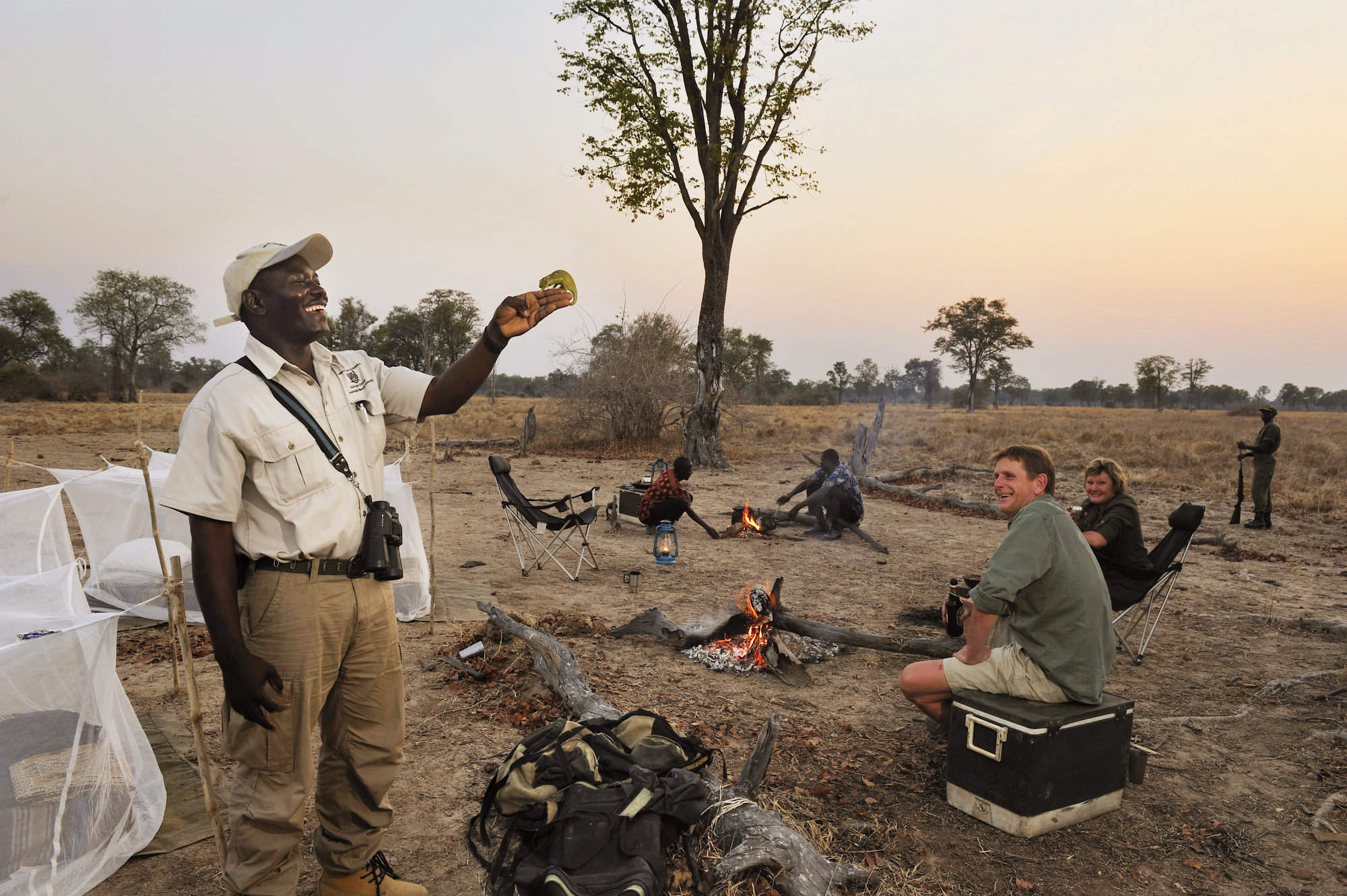
Mwamba Camp-out
The Mwamba-Camp Out allows you to have an incredibly adventurous night in the bush, sleeping under mosquito nets with activities led by some of the best guides in Zambia.
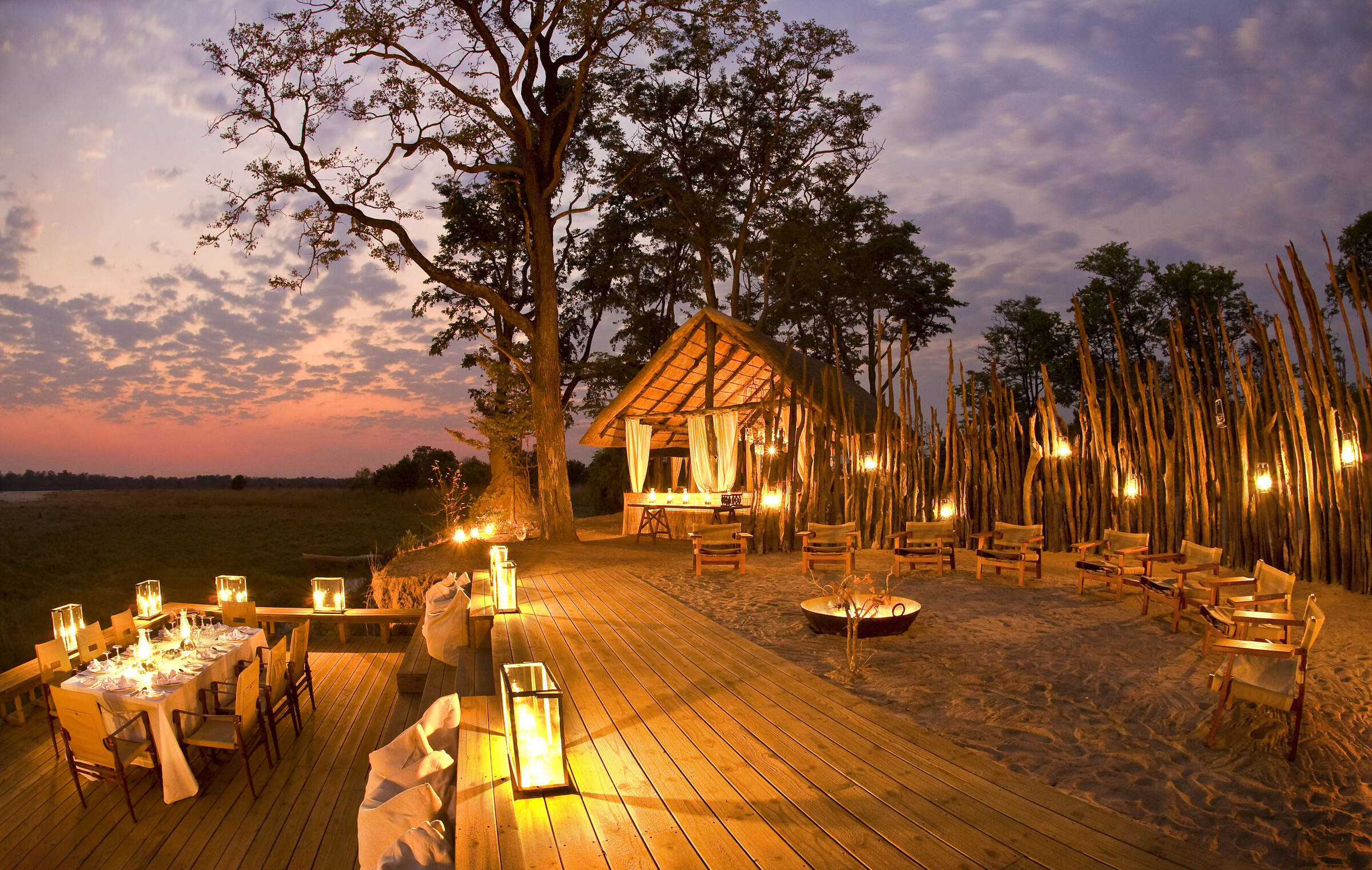
Zungulila
Zungulila is a small, comfortable tented bushcamp with an emphasis on walking safaris, in the remote southern section of the South Luangwa.
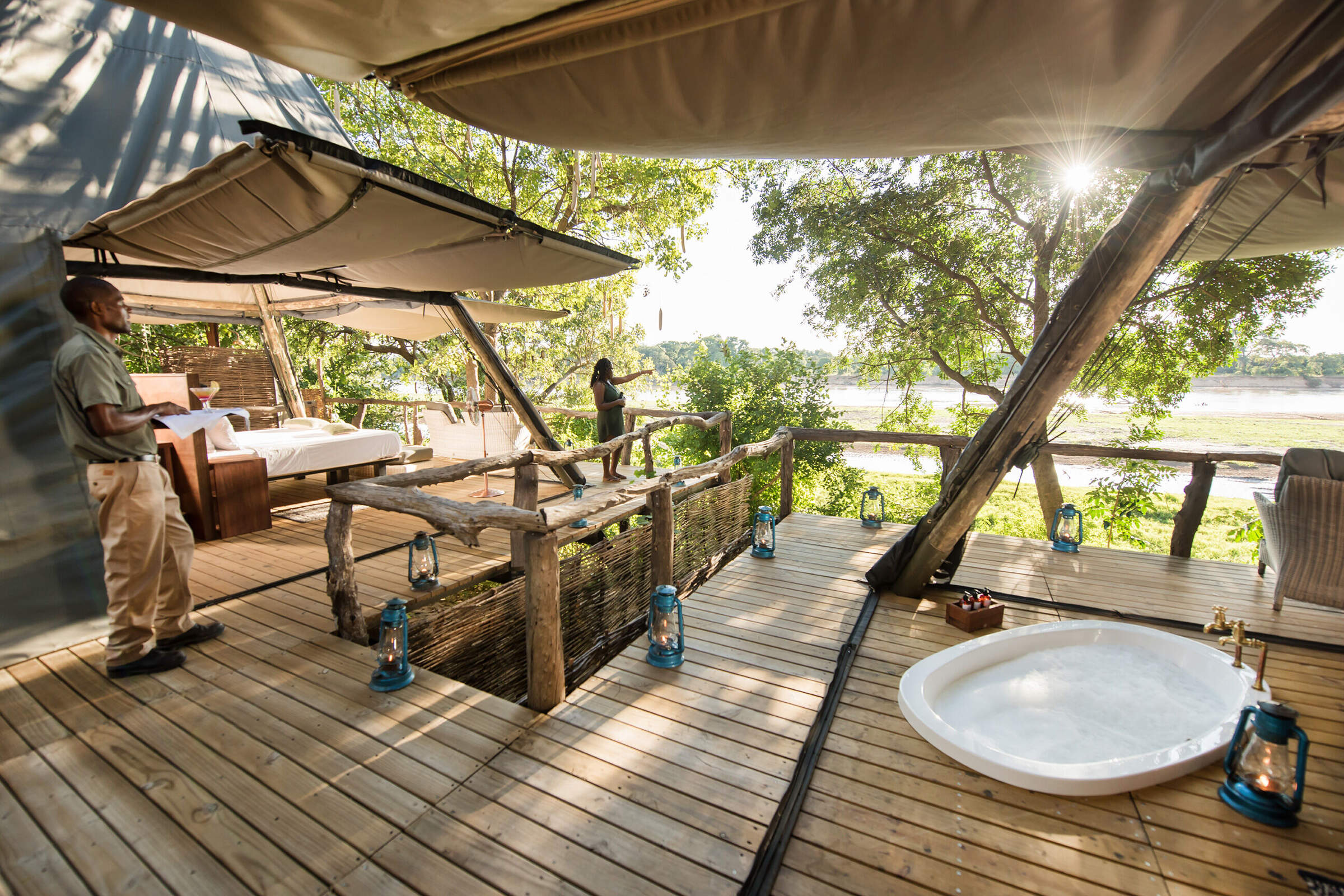
Shawa Luangwa
Opened in June 2021, Shawa Luangwa Camp is a small, intimate and rustic camp, with a good location in a remote section of the South Luangwa National Park.
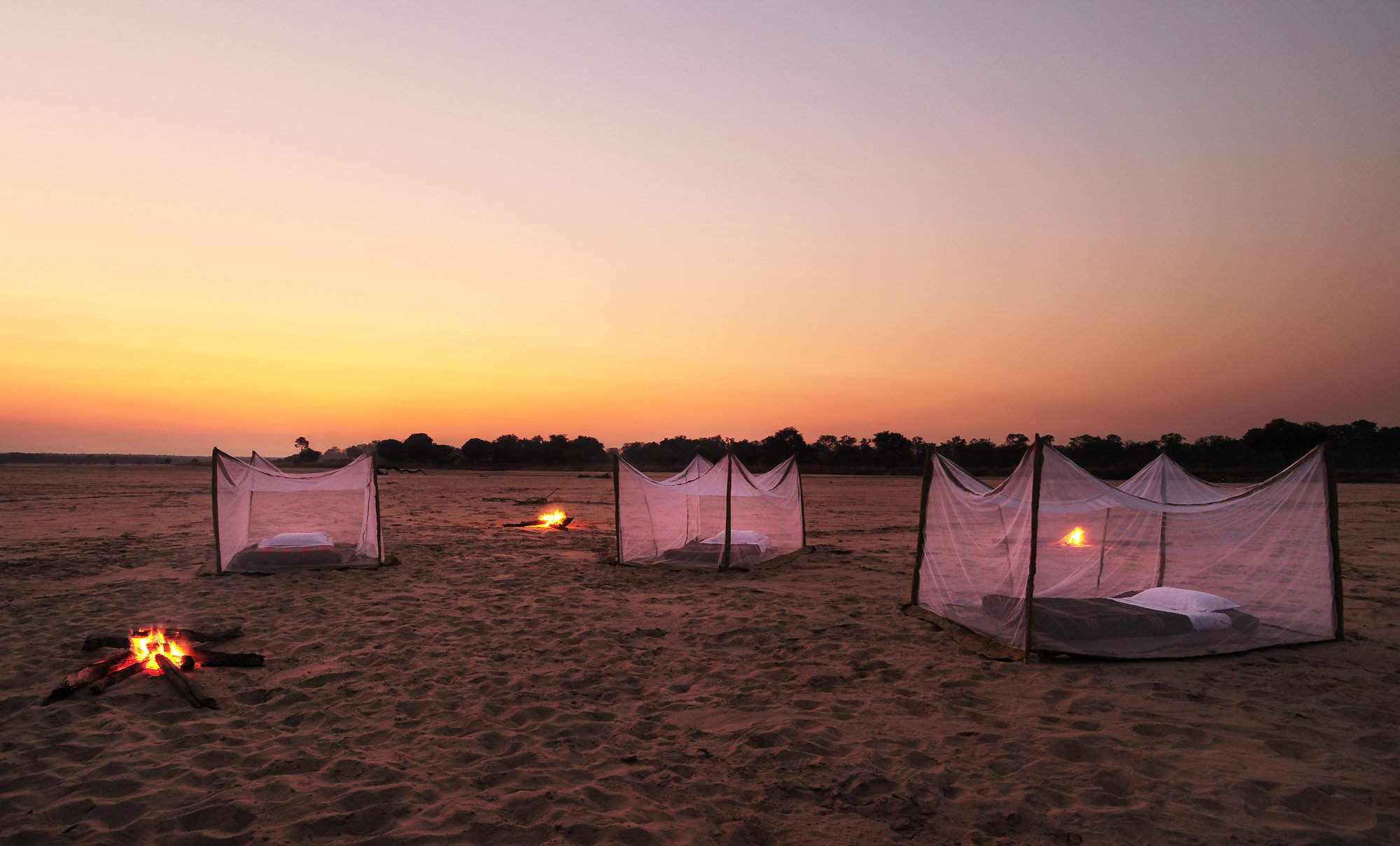
Luwi Riverbed Sleepout
For an adventurous night in South Luangwa National Park, come and sleep out in the bush, around a campfire, with an experienced guide and game scout.
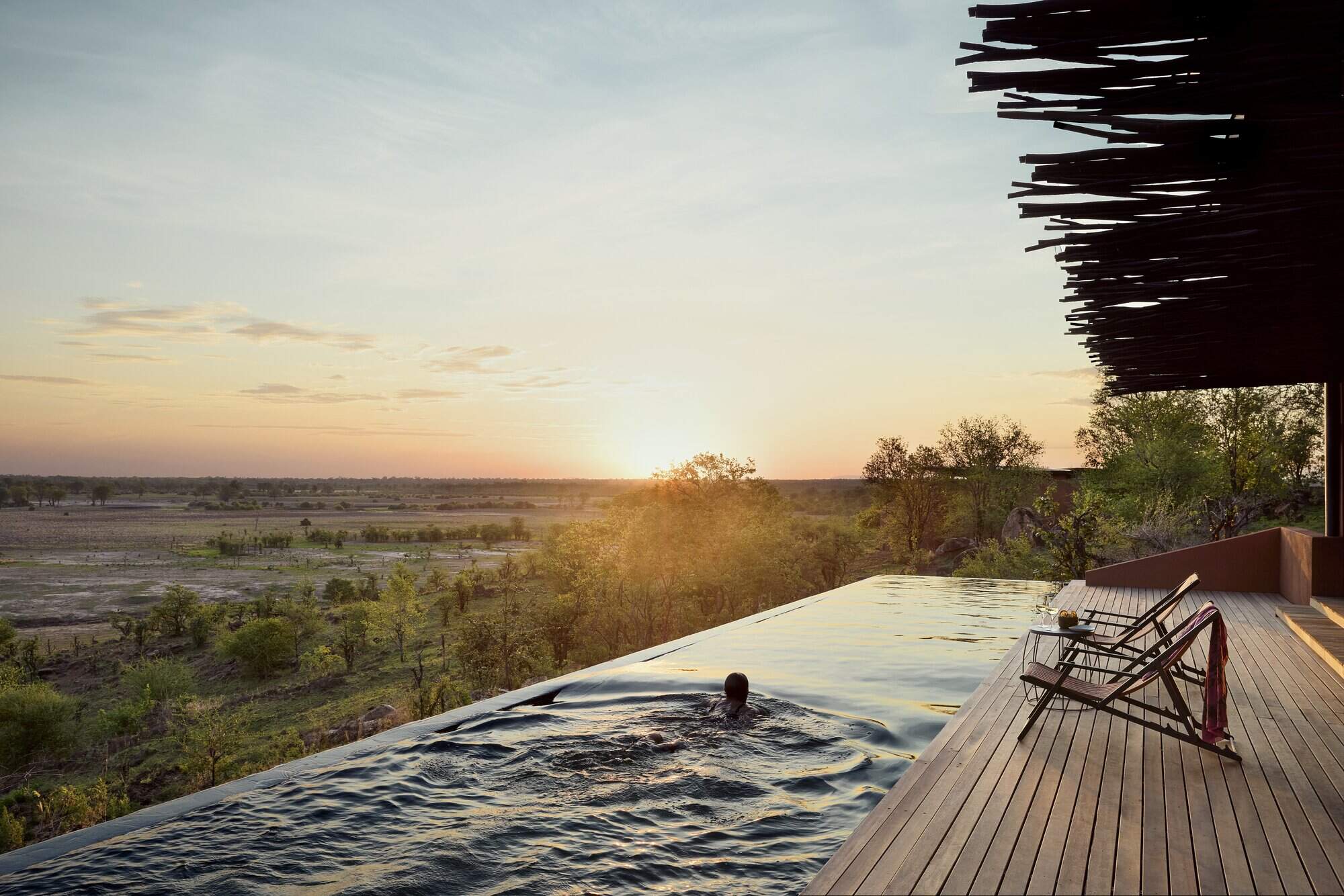
Chichele Lodge
Currently in the final stages of an extensive rebuild, Chichele Presidential Lodge stands high within the park, with superb views, and is due to reopen in early 2025.

Nkonzi Camp
A simple and rustic bush camp, Nkonzi has a strong focus on walking safaris in this remote section of Zambia’s South Luangwa National Park.
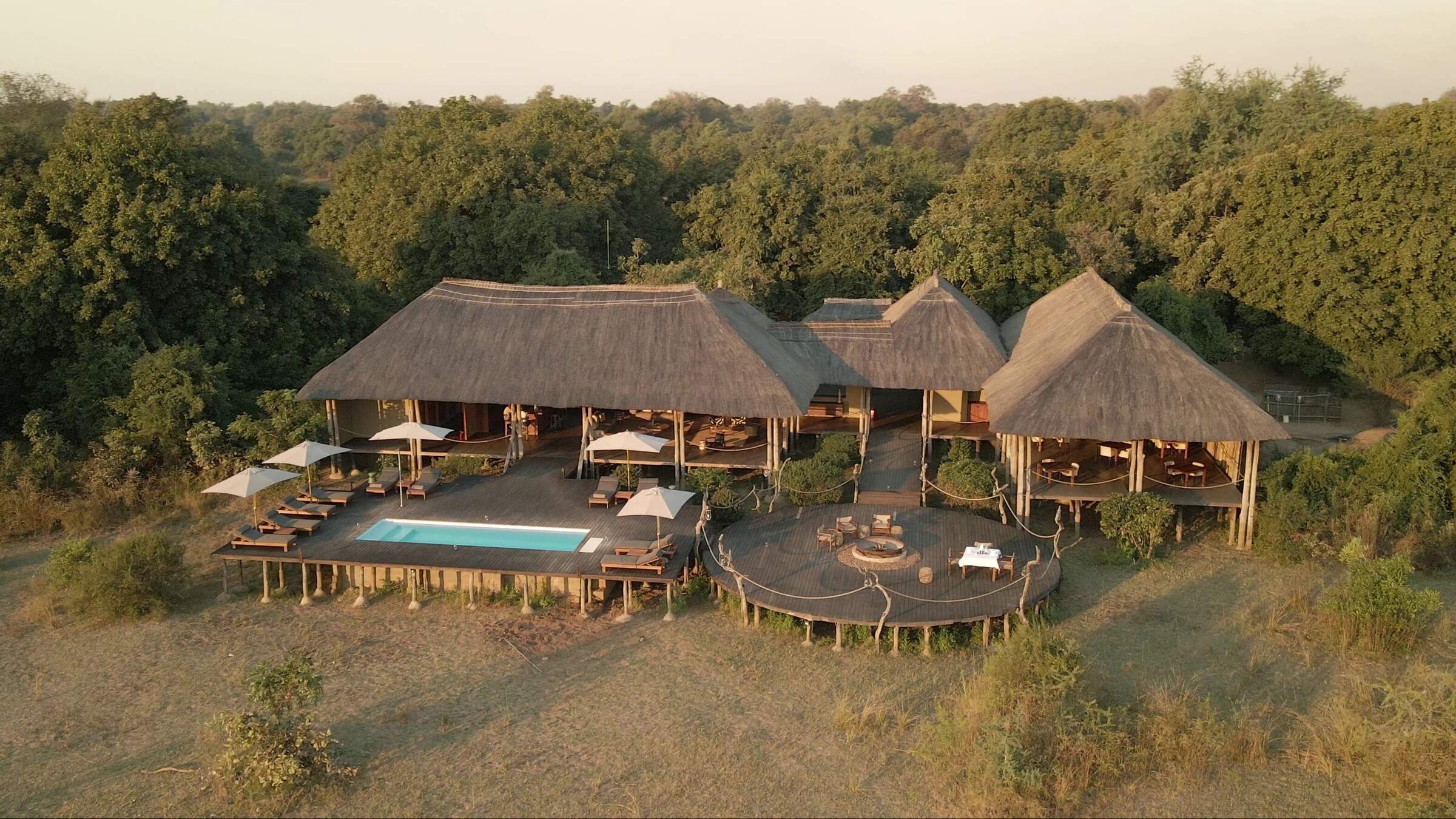
Chikunto
Chikunto Safari Lodge is a more traditional property in the South Luangwa National Park, sitting on a peninsula of land created by the meandering Luangwa River.
When to go to South Luangwa National Park
Our month by month guide: What it's like to visit Mwamba Bushcamp in South Luangwa National Park
Jan
Feb
Mar
Apr
May
Jun
Jul
Aug
Sep
Oct
Nov
Dec
South Luangwa National Park in January
January marks the height of the wet season in South Luangwa. Expect frequent downpours, often lasting a few hours, with intermittent sunny periods. The mercury regularly climbs above 30°C, accompanied by high humidity. The park's landscape is verdant and lush, with crystal-clear air.
However, the abundance of water causes most larger animals to disperse, and the thick vegetation can hinder game viewing. Walking safaris are largely impractical during this time. Migratory birds, many in breeding plumage, boost the area's avian diversity. Most lodges close and the few that remain open offer their lowest rates. Only the central network of all-weather roads is reliably passable for 4WD safaris. Low numbers of visitors ensuring a tranquil park experience for those who do visit.
- Wet season peak, frequent showers
- Most lodges and all bush-camps are closed
- Lush vegetation, ideal for photography
- Large wildlife is scattered, can be challenging to spot
- Few tourists, budget-friendly rates
Our view
This is not a great time to visit
Weather in January
South Luangwa National Park in February
February continues the ‘green season’ trend in South Luangwa National Park, with impressive thunderstorms delivering short bursts of rain most days, punctuated by clear skies. The park remains awash with water, affecting wildlife distribution and lodge operations.
Dense vegetation limits game viewing opportunities on safari and walking safaris aren’t usually possible. However, the swollen Luangwa River allows for unique boating experiences unavailable during drier months. Despite challenging conditions, patient visitors may be rewarded with sightings of animals caring for their young. The handful of operational lodges maintain low rates, and the park sees few visitors during this period.
- Continued wet season, regular downpours
- All bush-camps and most lodges are closed
- Verdant scenery, photogenic landscapes
- Game viewing challenging due to thick foliage
- Low visitor numbers, economical pricing
Our view
This is not a great time to visit
Weather in February
South Luangwa National Park in March
March signals the tail end of South Luangwa's rainy season, with heavy showers still frequent. Water levels peak, so driving off the park’s all-weather road network remains challenging. Daytime temperatures consistently exceed 30°C, with rain-induced humidity remaining high.
Most lodges are still closed, and thick vegetation continues to impact game viewing and walking safaris. However, this period can offer exceptional sightings of animals with their offspring, and predator activity often increases. Wild dogs have historically been particularly active in the park during this time. The combination of clear air and increasingly blue skies provides excellent photographic opportunities. Birdwatching remains superb as migratory species prepare for their winter journey.
- Wet season persists, intermittent rain
- Many lodges remain closed
- Abundant greenery, picturesque settings
- Young animals plentiful, but hard to see
- Minimal crowds, cost-effective travel
Our view
This is not a great time to visit
Weather in March
South Luangwa National Park in April
April represents a transitional period in South Luangwa National Park as the rains shift from intense downpours to lighter, less frequent showers. The park's scenery remains incredibly green and vibrant, though larger wildlife can be harder to spot on safaris.
Some lodges begin to reopen while seasonal bushcamps remain closed as they prepare for the upcoming dry season. The Luangwa River reaches often its highest level in April, creating a spectacular sight. Despite the challenges, this period can offer unique experiences for those willing to brave the unpredictable conditions – and accept a greatly reduced choice of places to stay.
- Wet season waning, occasional showers
- Some lodges begin reopening
- Landscape still lush, great for photographers
- Wildlife viewing slowly improving
- Few visitors, attractive off-season rates
Our view
This is not a great time to visit
Weather in April
South Luangwa National Park in May
May is a lovely month; it typically heralds the start of the dry season in South Luangwa. While occasional showers may occur, most days are clear and sunny. As winter approaches, temperatures begin to drop, with daytime highs around 26°C.
The drying landscape improves access within the park, and most lodges reopen. Some standing water remains, but game viewing noticeably improves as the vegetation thins out. The clear air continues to benefit photographers. Late May is very popular among the Luangwa’s ‘safari regulars’ who seek to capitalise on good weather, improved wildlife sightings, newly-opened camps (including some seasonal bush-camps) and the final weeks of low-season rates at many lodges.
- Dry season onset, clearer skies
- Most lodges and some bush-camps operational
- Vegetation still green, crisp air
- Game viewing conditions improving
- Last month for lower accommodation prices
Our view
A good time to visit, with pros & cons
Weather in May
South Luangwa National Park in June
June in South Luangwa National Park is characterised by virtually rainless days and abundant sunshine. Humidity levels plummet, and winter's approach brings cooler temperatures, with nighttime lows around 10°C and daytime highs of 25°C.
The landscape remains lush, but the thinning vegetation significantly enhances visibility for game viewing, the conditions are ideal for walking safaris. All the lodges and bushcamps in the park are operational by early June. While some offer shoulder season rates, others are already running with high-season pricing. Wildlife begins to concentrate around water sources, setting the stage for excellent game viewing in the coming months.
- Consistently sunny, cooler nights
- All South Luangwa lodges open
- Wildlife sightings becoming more frequent
- Ideal conditions for walking safaris
- Viewing of the Victoria Falls at its best
Our view
A very good time to visit
Weather in June
South Luangwa National Park in July
As the dry season progresses in South Luangwa, July sees vegetation and grasses dying back, with water becoming increasingly scarce. Wildlife congregates around remaining water sources, most notably along the Luangwa River, leading to excellent game viewing opportunities.
July marks the heart of winter, with daytime temperatures in the 20s Celsius, whilst nighttime lows can drop to single digits. Early morning and late evening game drives can be particularly chilly, with lodges often providing blankets and hot water bottles. Bring your hats, coats and gloves! Visitor numbers rise significantly, and space at popular small camps can become limited. Nearly all properties now charge their highest rates.
- Warm days, chilly evenings
- Game viewing notably improved
- Excellent visibility for walking safaris
- High season prices for most camps and lodges
- Comfortable daytime temperatures
Our view
A very good time to visit
Weather in July
South Luangwa National Park in August
August in the national park offers some of the year's best game viewing opportunities. South Luangwa’s vegetation has largely died back, and wildlife clusters around remaining water sources.
Rain is extremely unlikely, with sunny days largely guaranteed, though a haze may sometimes appear on the horizon due to dust and smoke in the air. Nighttime temperatures can dip below 5°C, but daytime highs reach the 20s Celsius. Warm clothing is essential for morning and evening drives. This is one of the most popular months to visit the park for a safari, with lodges and camps charging peak rates and often booking up far in advance.
- Very dry warm days and cold nights
- Prime wildlife viewing near water sources
- Perfect weather for walking safaris
- Peak season means highest prices
- Some haze may affect photography
Our view
Fantastic: the very best time to visit
Weather in August
South Luangwa National Park in September
September is arguably the very best time to visit South Luangwa National Park. It probably hasn’t rained for many months, humidity is low, and temperatures are just beginning to climb.
Mornings are more comfortable for 4WD safaris, rising to daytime typical highs in the low 30s Celsius. Water scarcity forces the wildlife to congregate around remaining sources, particularly around the Luangwa River, where most of the camps and lodges are situated. There high game densities lead to increased chances of inter-species interactions. It’s peak season for lodges and camps charge which are often fully booked. A little haze may affect long-distance views and photography. The Luangwa River's water levels continue to drop, concentrating hippos and crocodiles life in the remaining stretches.
- Dry and hot, clear skies
- Exceptional month for wildlife observation
- Landscape sometimes hazy due to dust and smoke
- Peak season, lodges often fully booked
- Higher prices for accommodation
Our view
Fantastic: the very best time to visit
Weather in September
South Luangwa National Park in October
October sees the dry season peak in South Luangwa at its most intense, with the landscape increasing parched. Occasional showers may occur as the promise of rain approaches. Temperatures can soar above 40°C during the day, rarely dropping below 20°C at night.
This heat can be draining, so walking safaris will set off early in the morning to beat the heat and sitting in an open 4WD on safaris can feel like facing a large hair-drier. Heat-haze and smoke may obscure the horizon as the Luangwa River becomes a series of pools, crowded with hippos and crocodiles. Other wildlife cautiously approaches these water sources, leading to thrilling predator-prey interactions. Game viewing is at its absolute best with the best chance of witnessing hunts.
- Optimal wildlife viewing conditions
- Very hot days and nights
- Dusty, hazy atmosphere is challenging for photos
- Some lodges start lowering their rates
- Less crowded than previous months
Our view
A very good time to visit
Weather in October
South Luangwa National Park in November
November typically witnesses the end of the dry season in South Luangwa. While the onset of rains is unpredictable, temperatures remain consistently high and humidity builds as the wet season approaches.
Early November may still be dry, but spectacular thunderstorms usually arrive, often later in the month, triggering rapid green growth when they do come – and an explosion of life from insects and smaller animals. Everything seems to come to life! When pools of water becomes more readily available away from the Luangwa River the wildlife quickly disperses. Some camps and all the seasonal bush-camps camps close; those that remain open reduce their rates. The rains quickly clear the air of dust and smoke, improving visibility and photographic conditions.
- Unpredictable month: depends on the rains
- Hot and humid – then the set season begins
- Wildlife dispersing as vegetation thickens
- Lower accommodation rates, fewer tourists
- Improved conditions for landscape photography
Our view
A good time to visit, with pros & cons
Weather in November
South Luangwa National Park in December
December usually marks the first full month of South Luangwa's wet season. Heavy thunderstorms become frequent, interspersed with sunny intervals. Daytime temperatures often exceed 30°C, accompanied by high humidity.
The rainfall transforms the landscape, encouraging lush vegetation growth. It’s a time renewal when insects, birds and smaller wildlife abound. While the larger species of wildlife remains in the park, wildlife viewing becomes more challenging due to the thick greenery and dispersed animal populations. Many lodges and all seasonal bush-camps are now closed as access to the park’s outlying areas becomes difficult. The few lodges that remain open offer lower rates and see few visitors. The rains clear the air, restoring vibrant blue skies and crystal-clear air which delights photographers.
- Rainy season in full swing
- Most lodges closed or offering low rates
- Wildlife harder to spot in thick vegetation
- Few visitors, budget-friendly period
- Lush green scenery, very photogenic landscapes
Our view
This is not a great time to visit
Weather in December

Looking for inspiration on where to travel next?
Visit our trip chooser to explore your options and find inspiration for your perfect African adventure
Inspire me